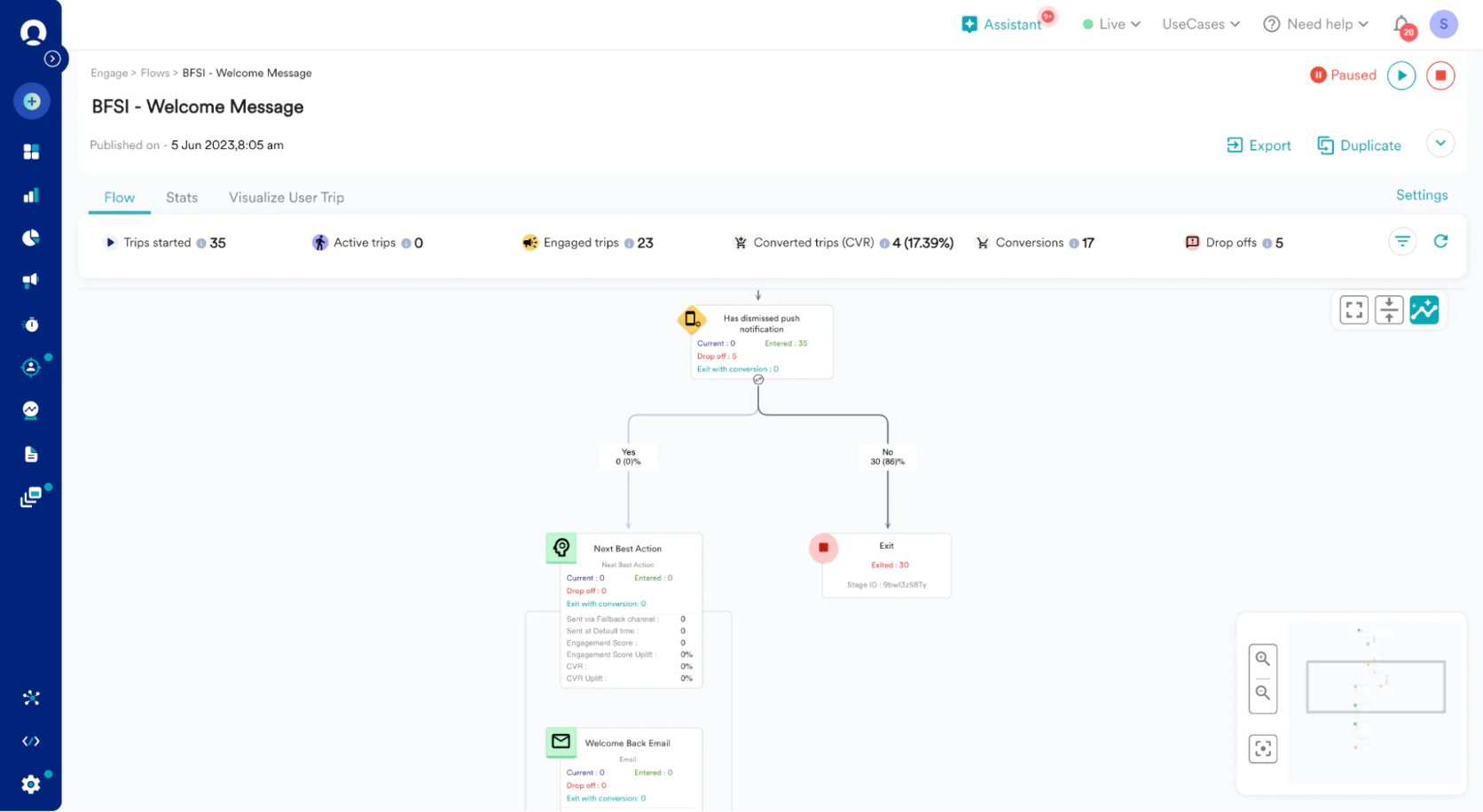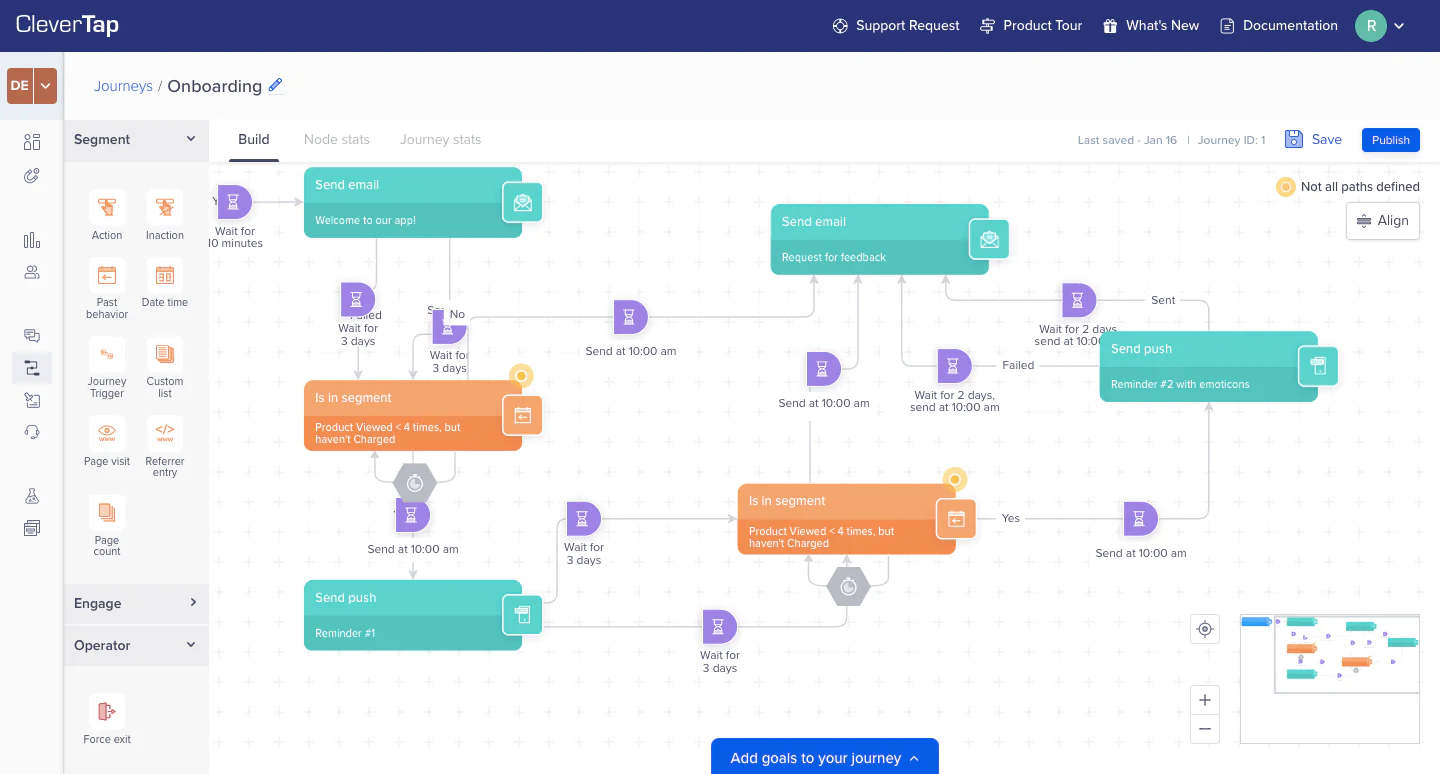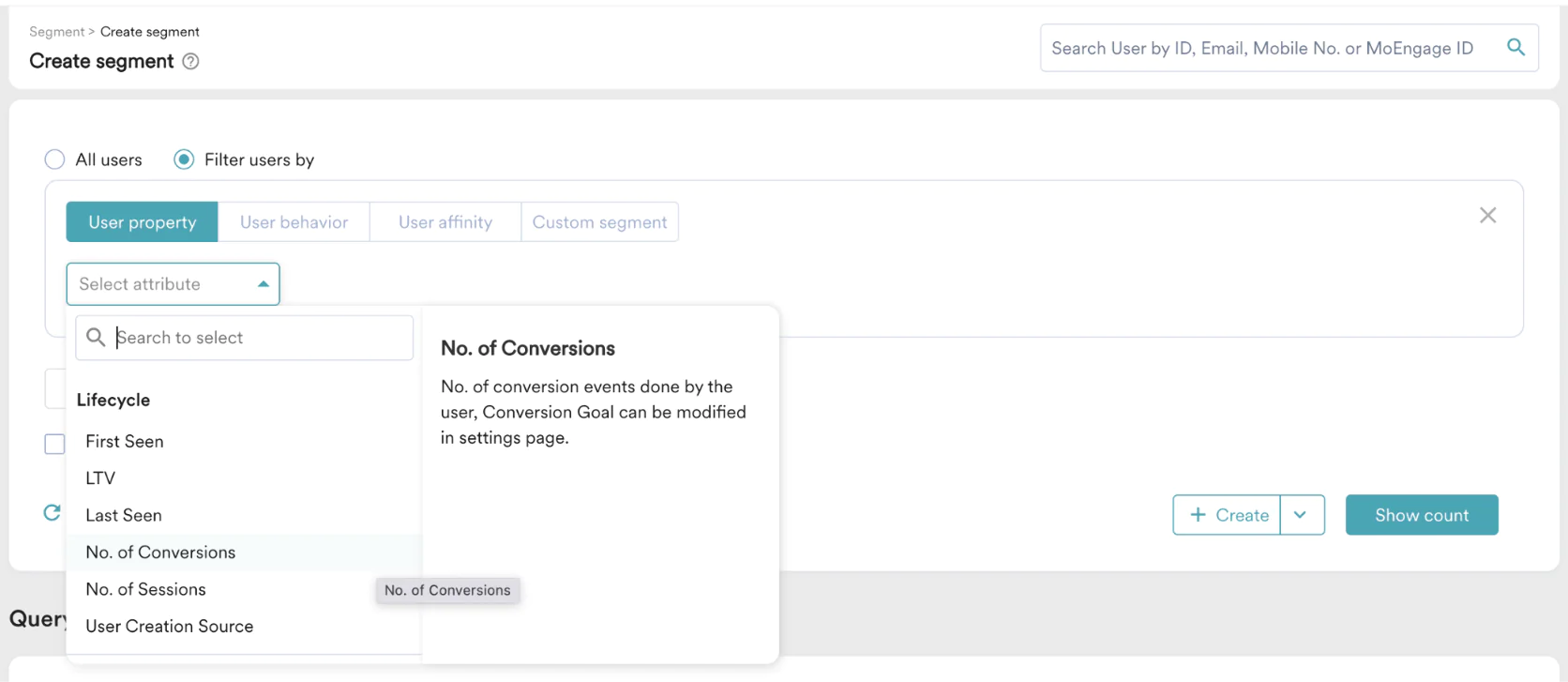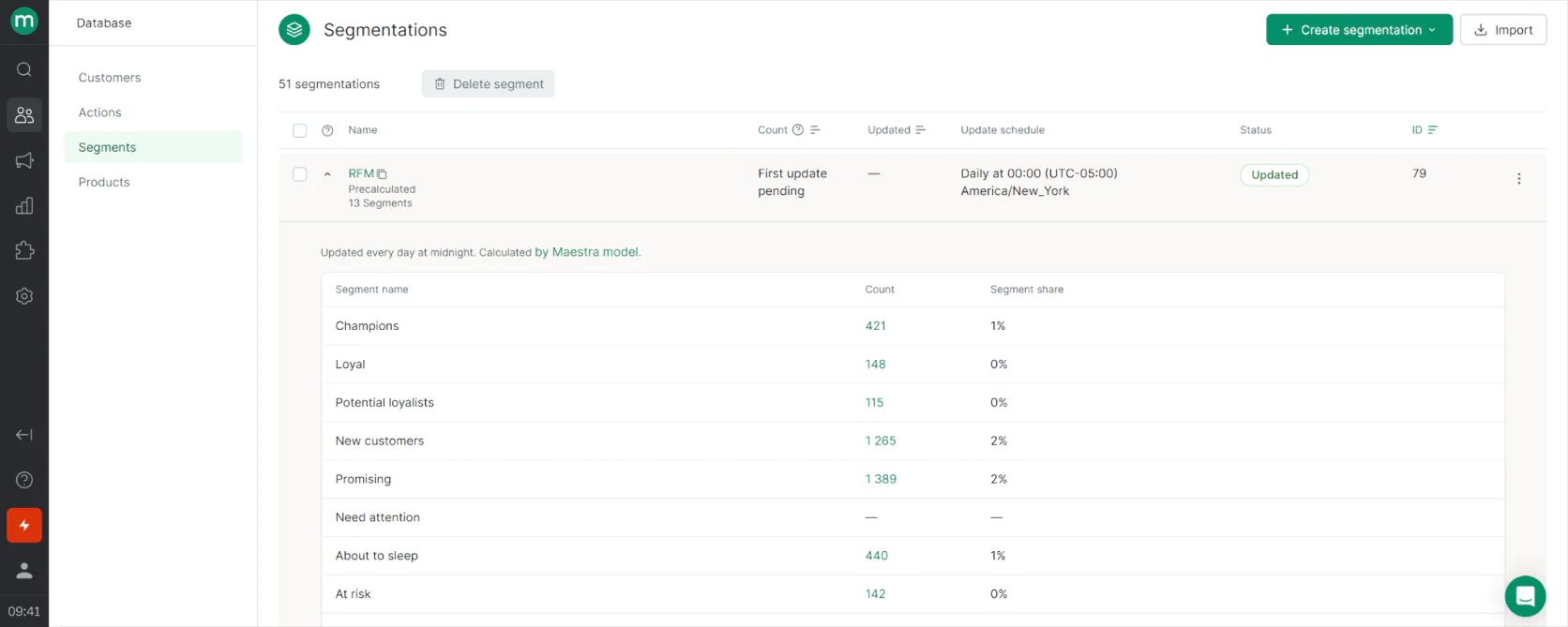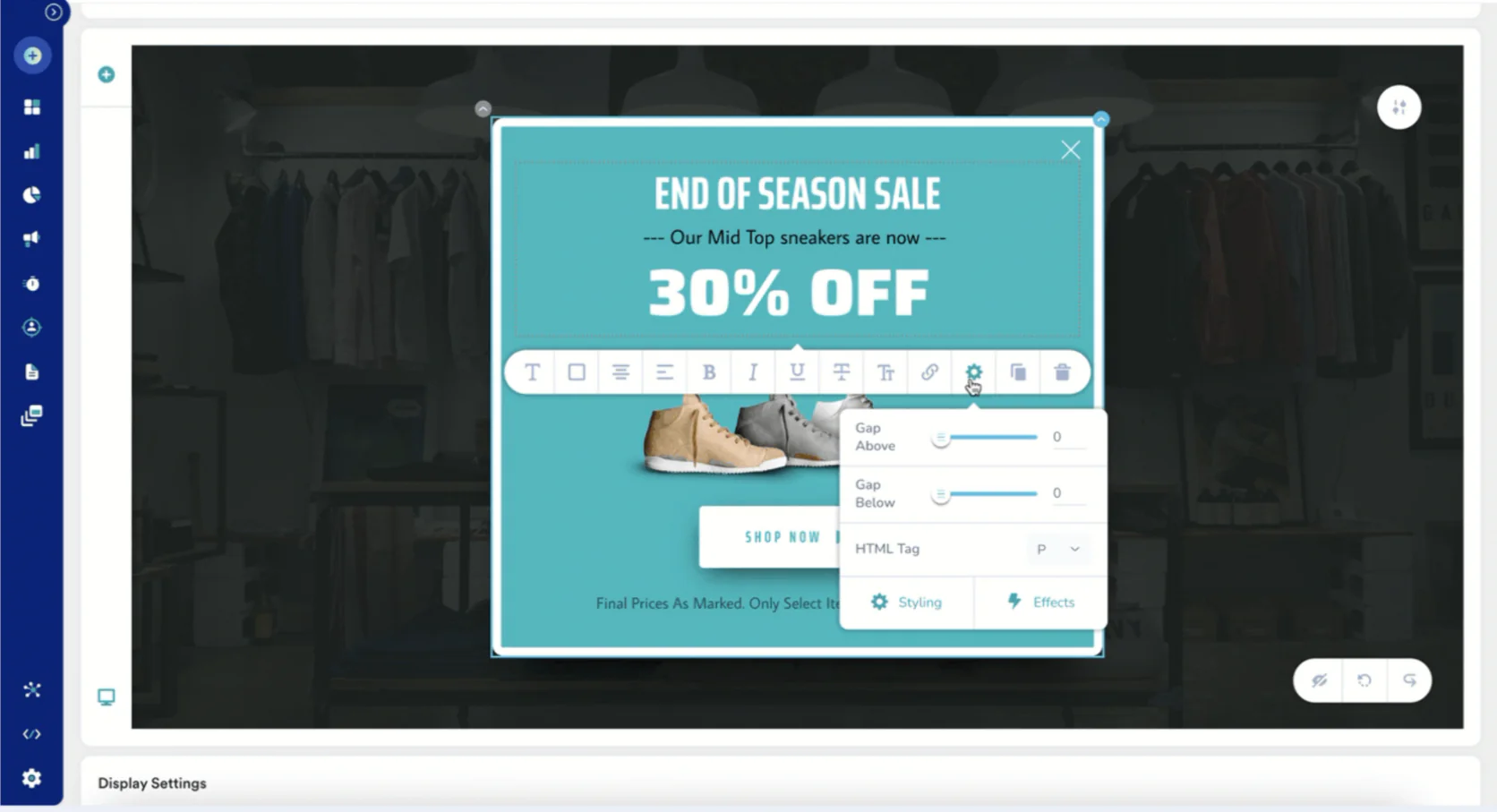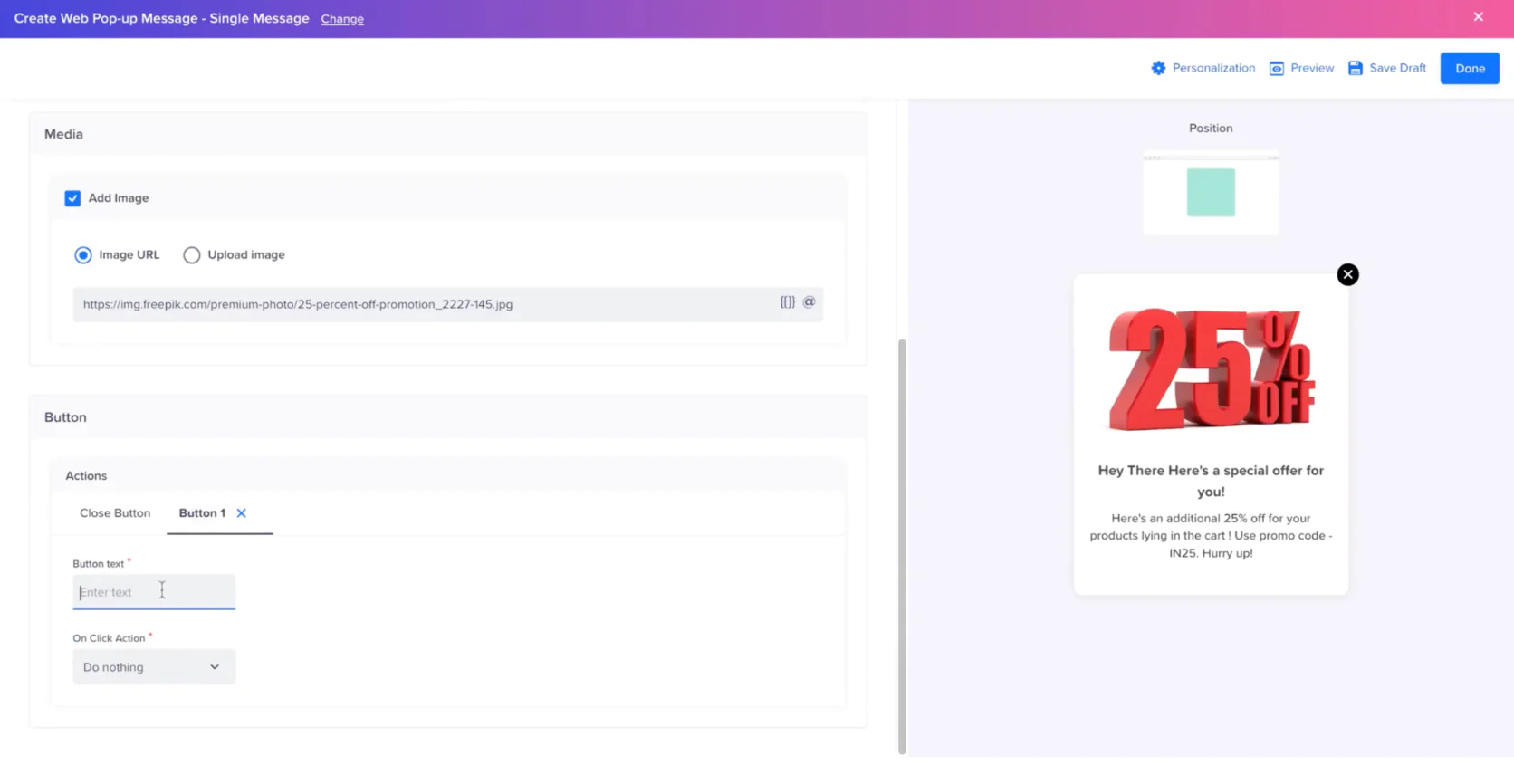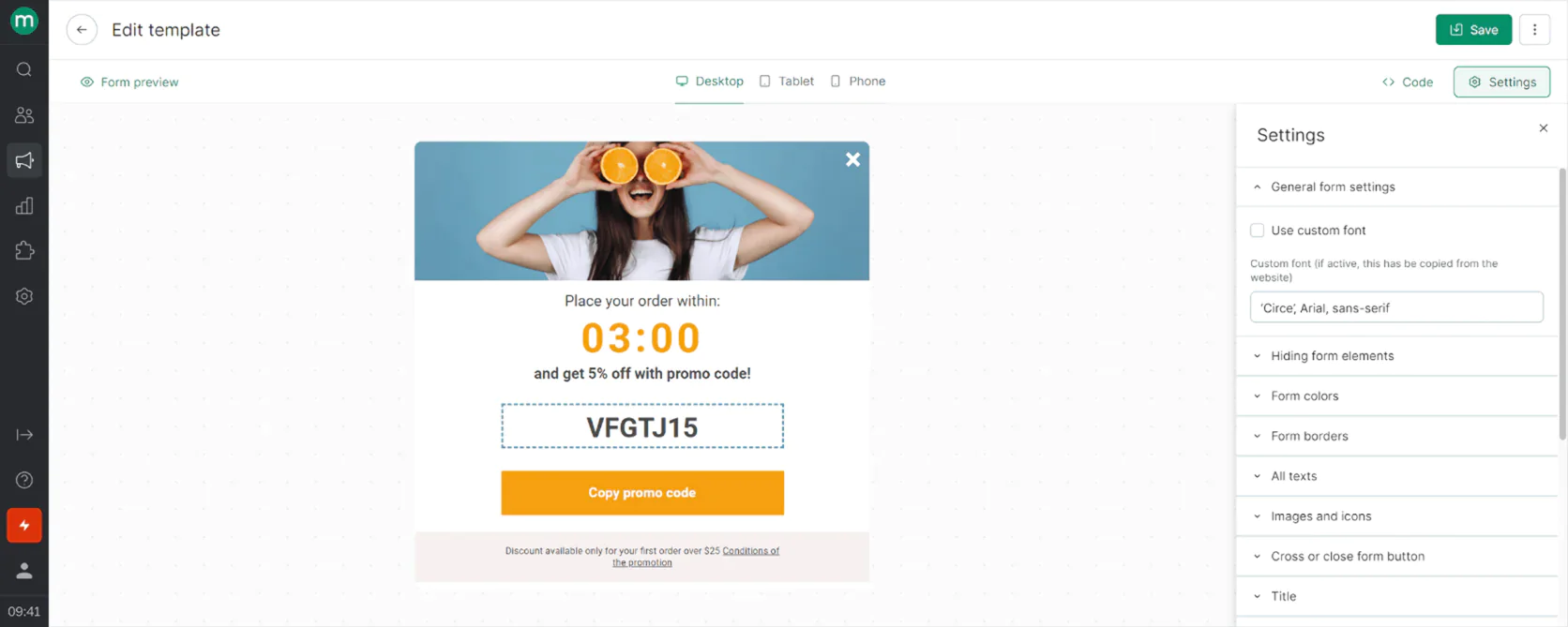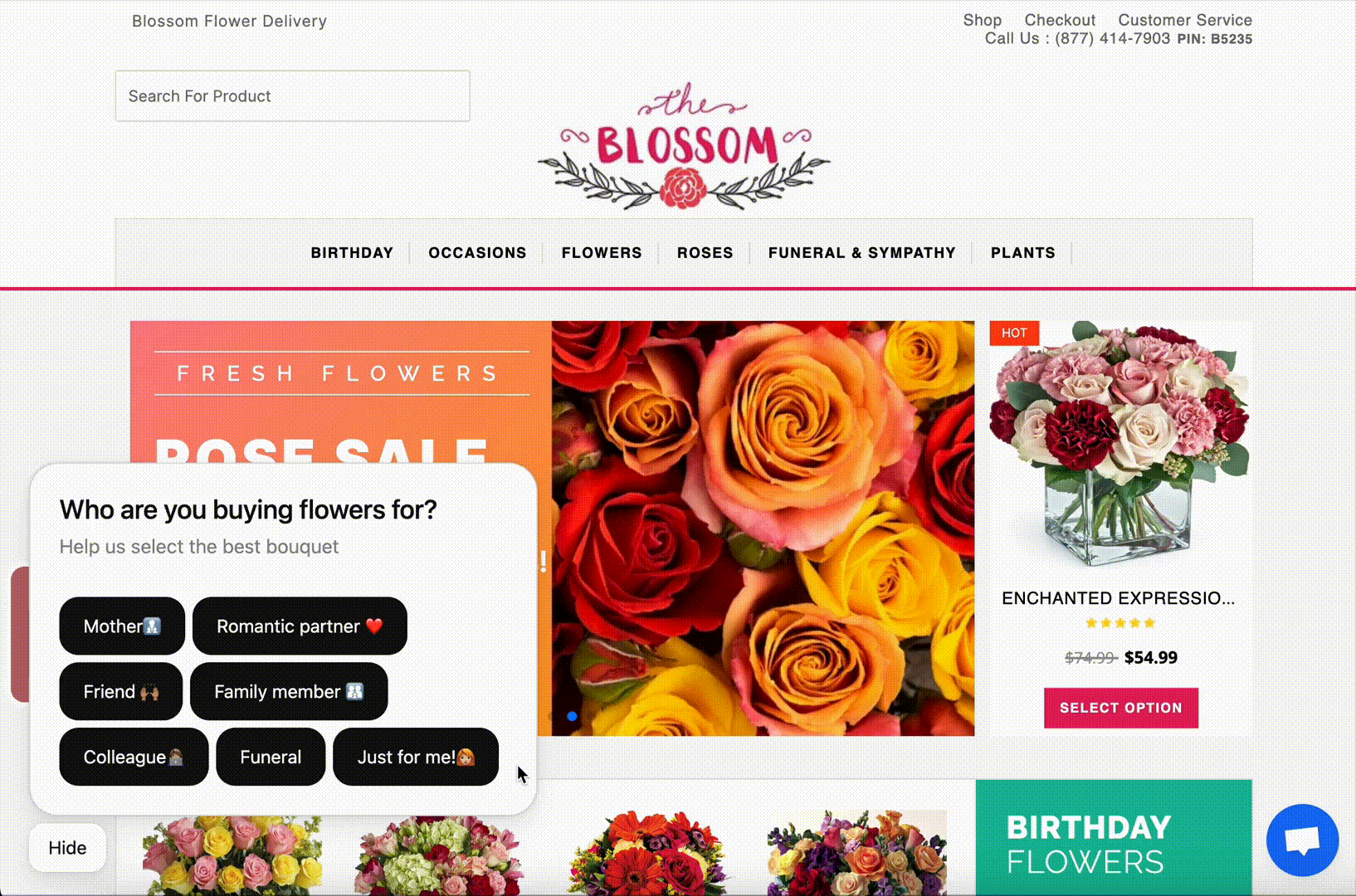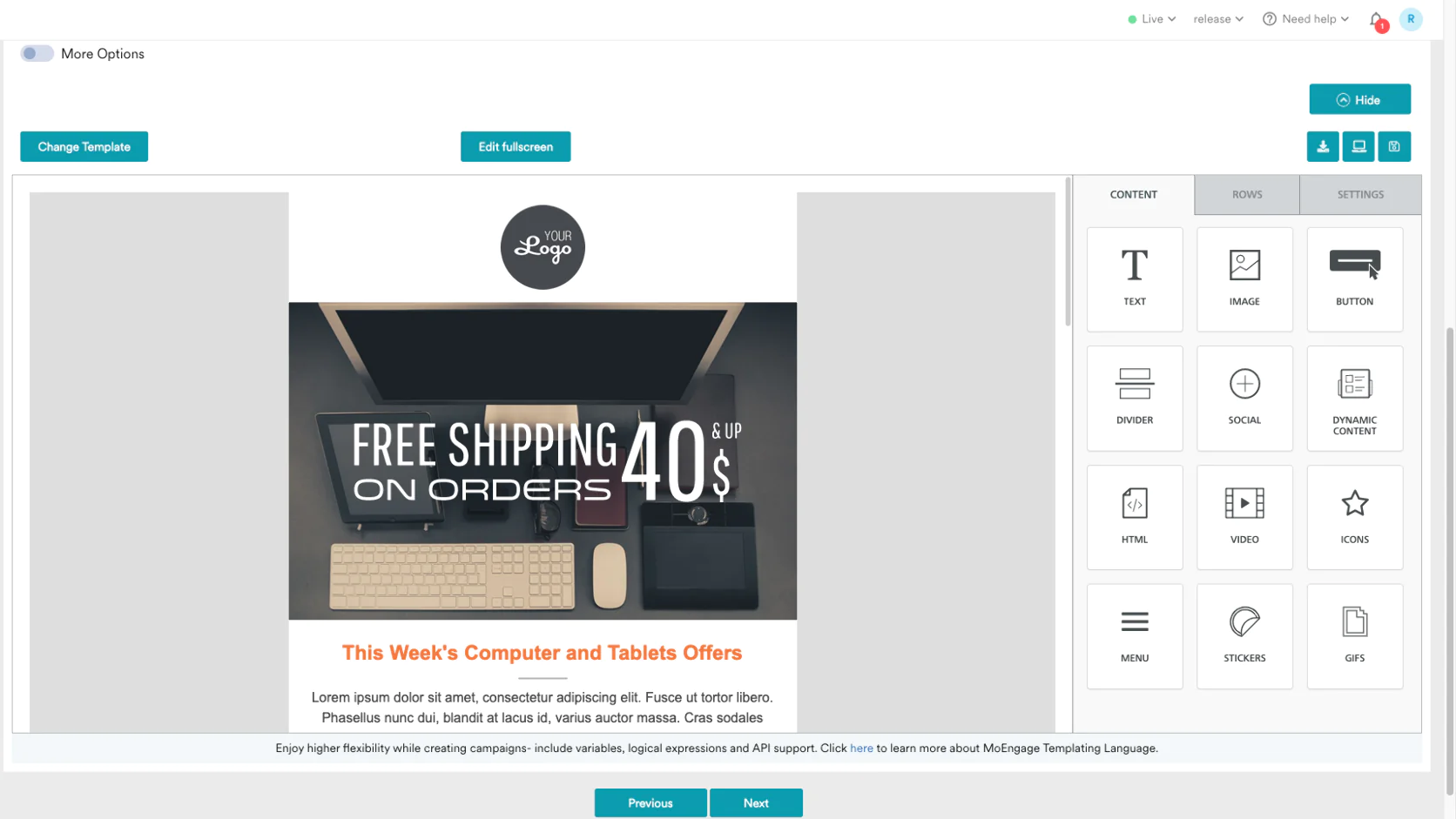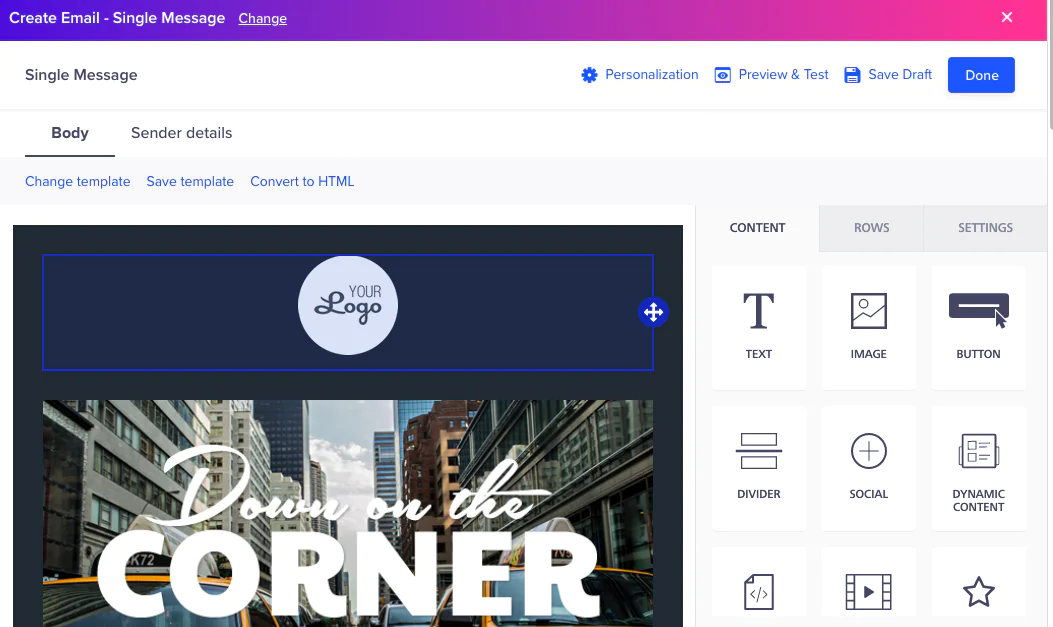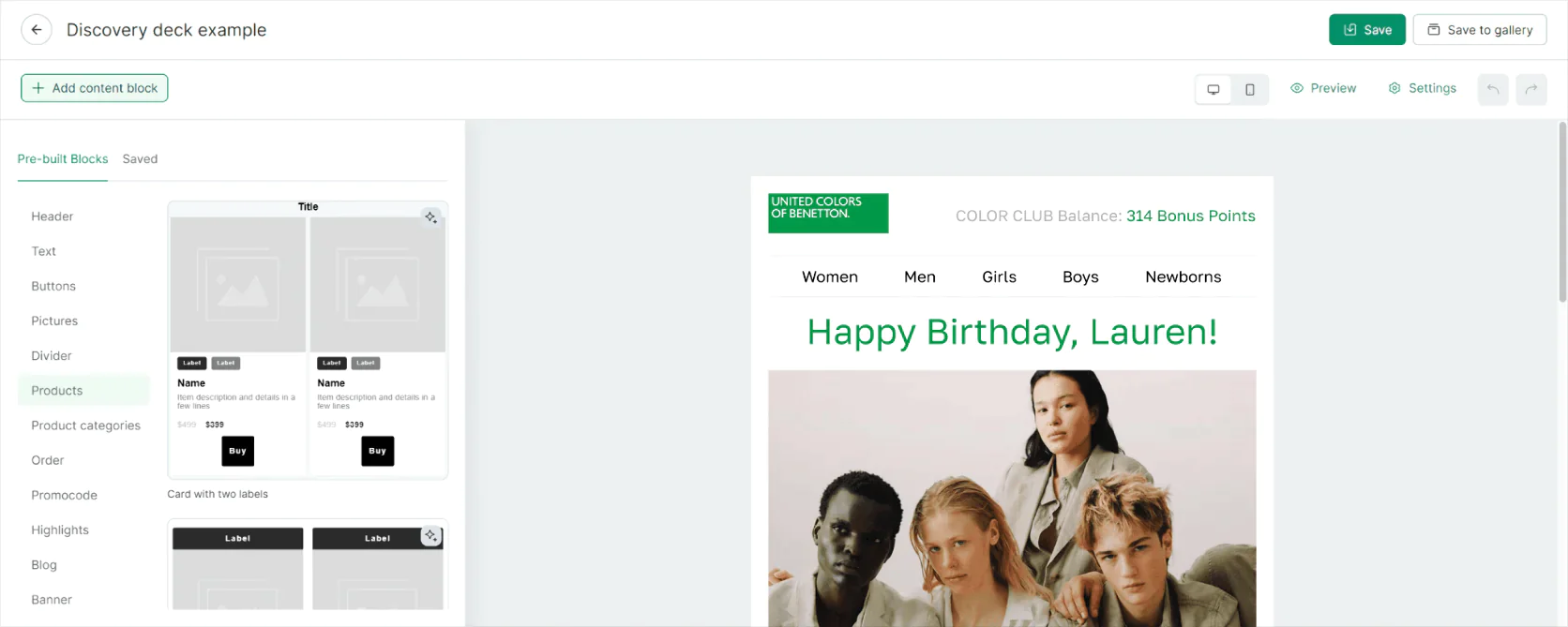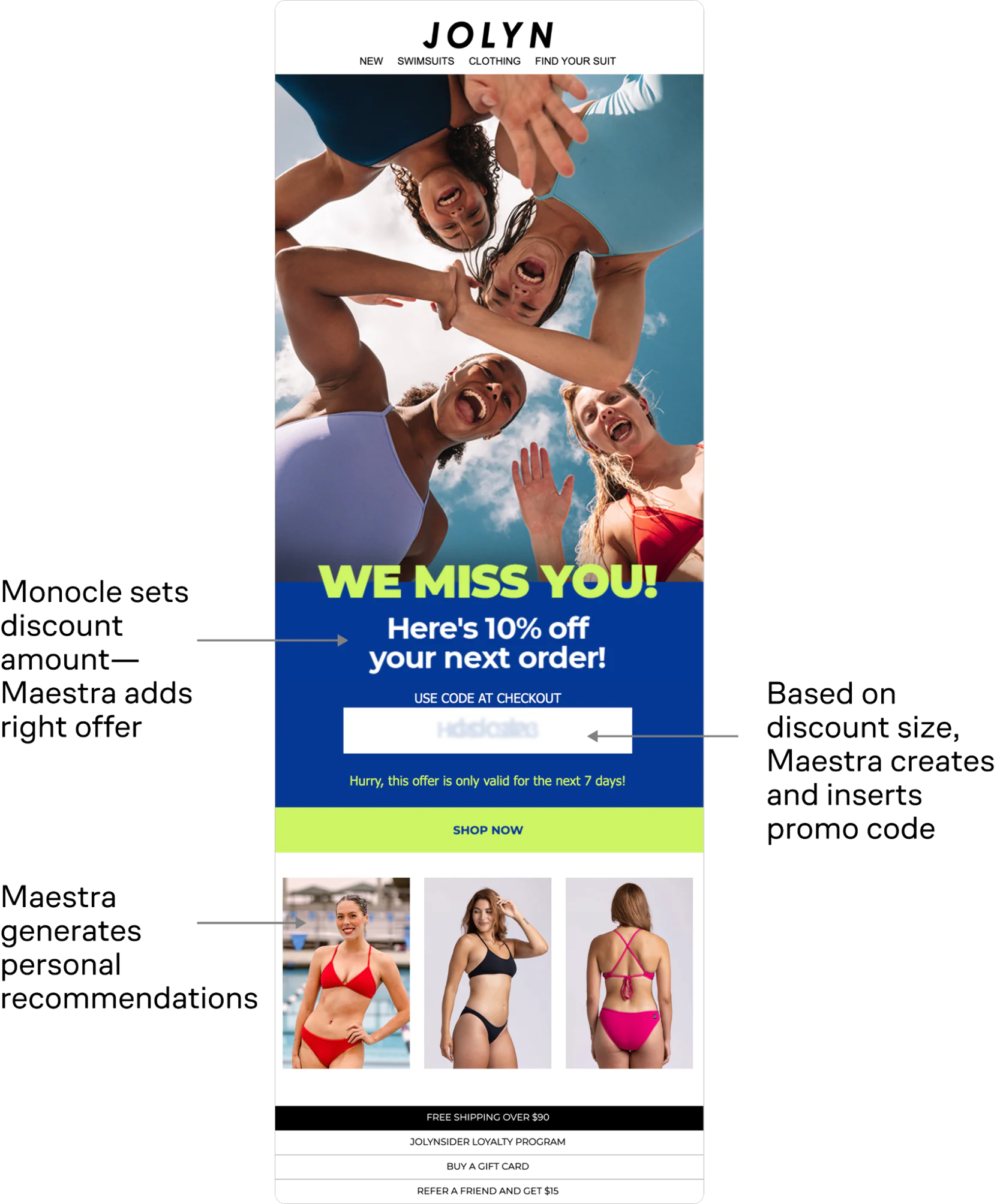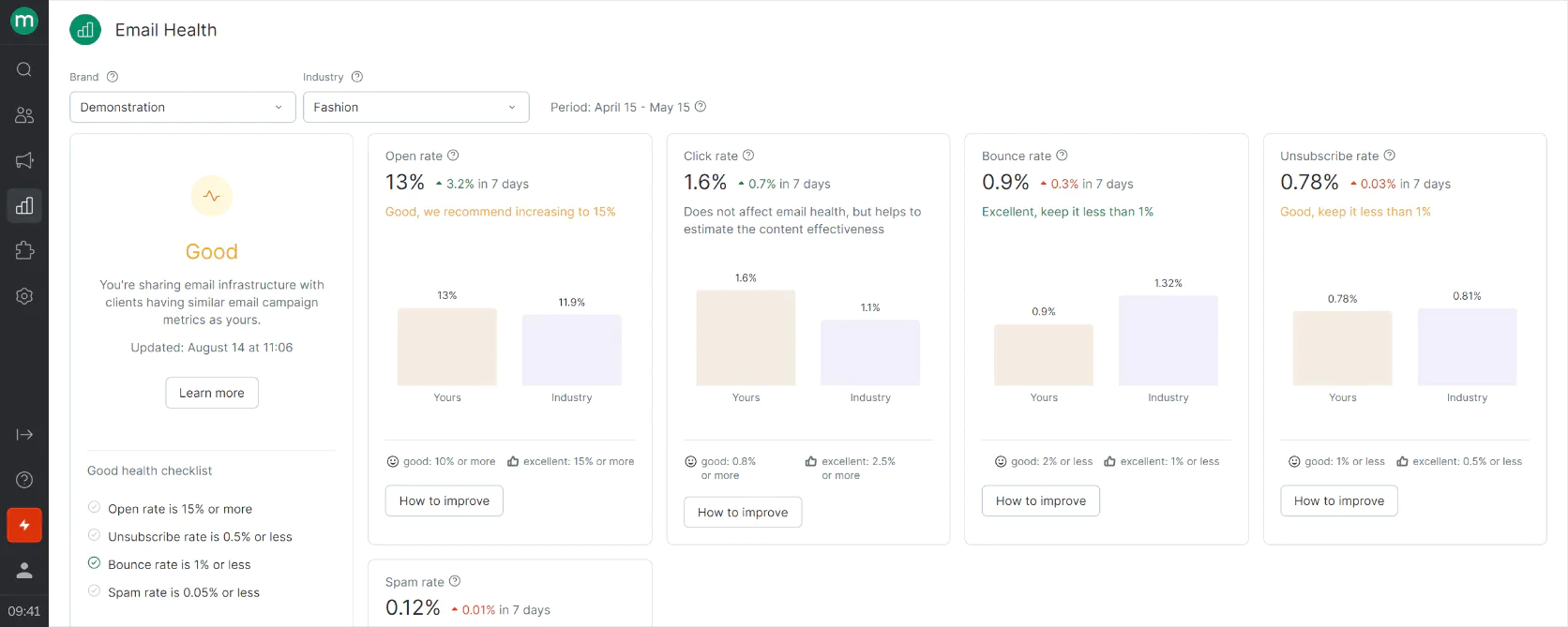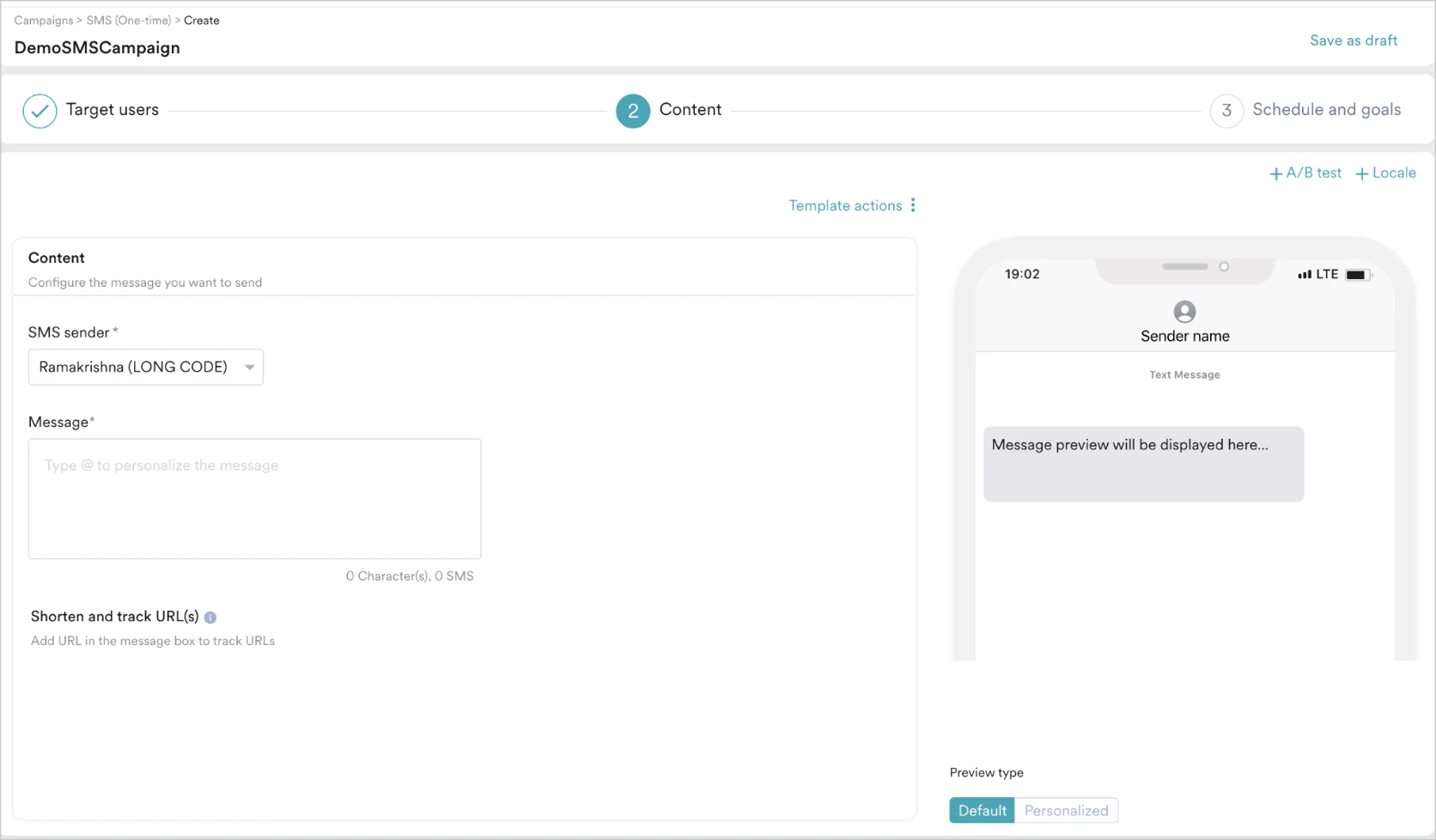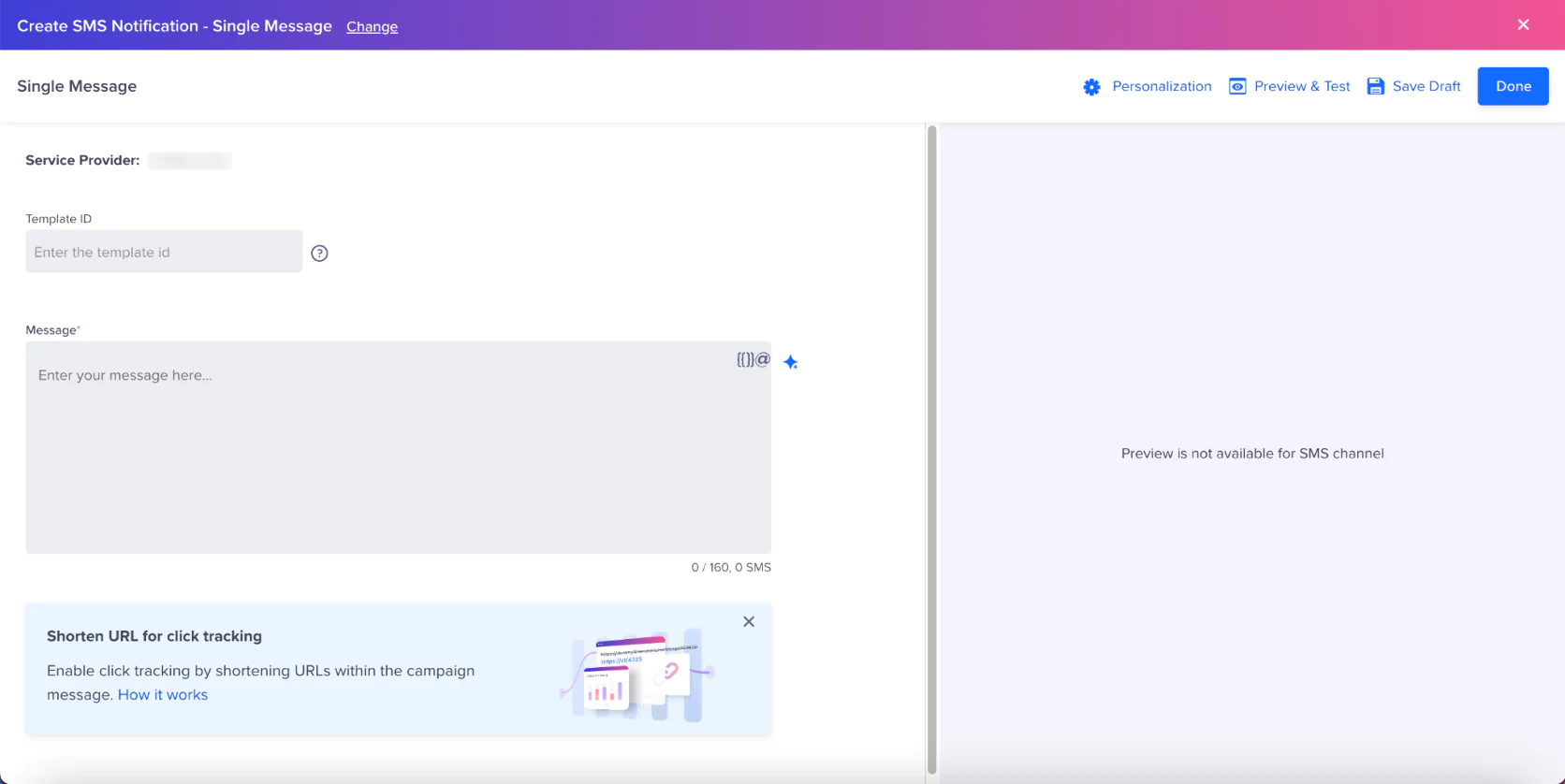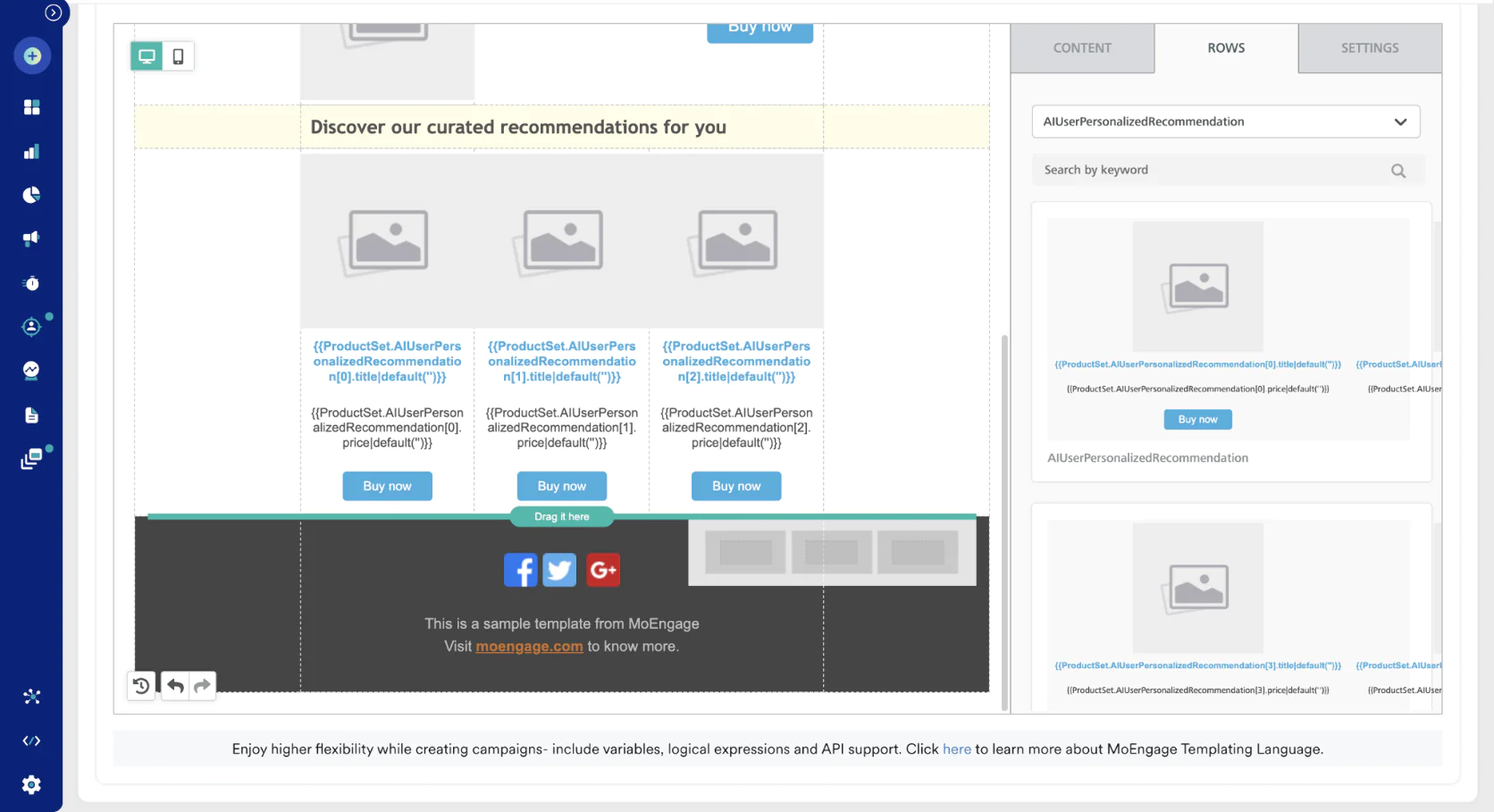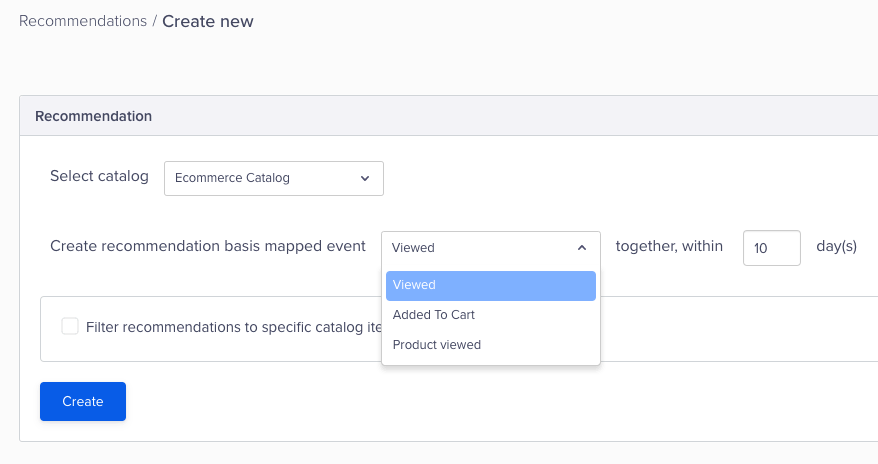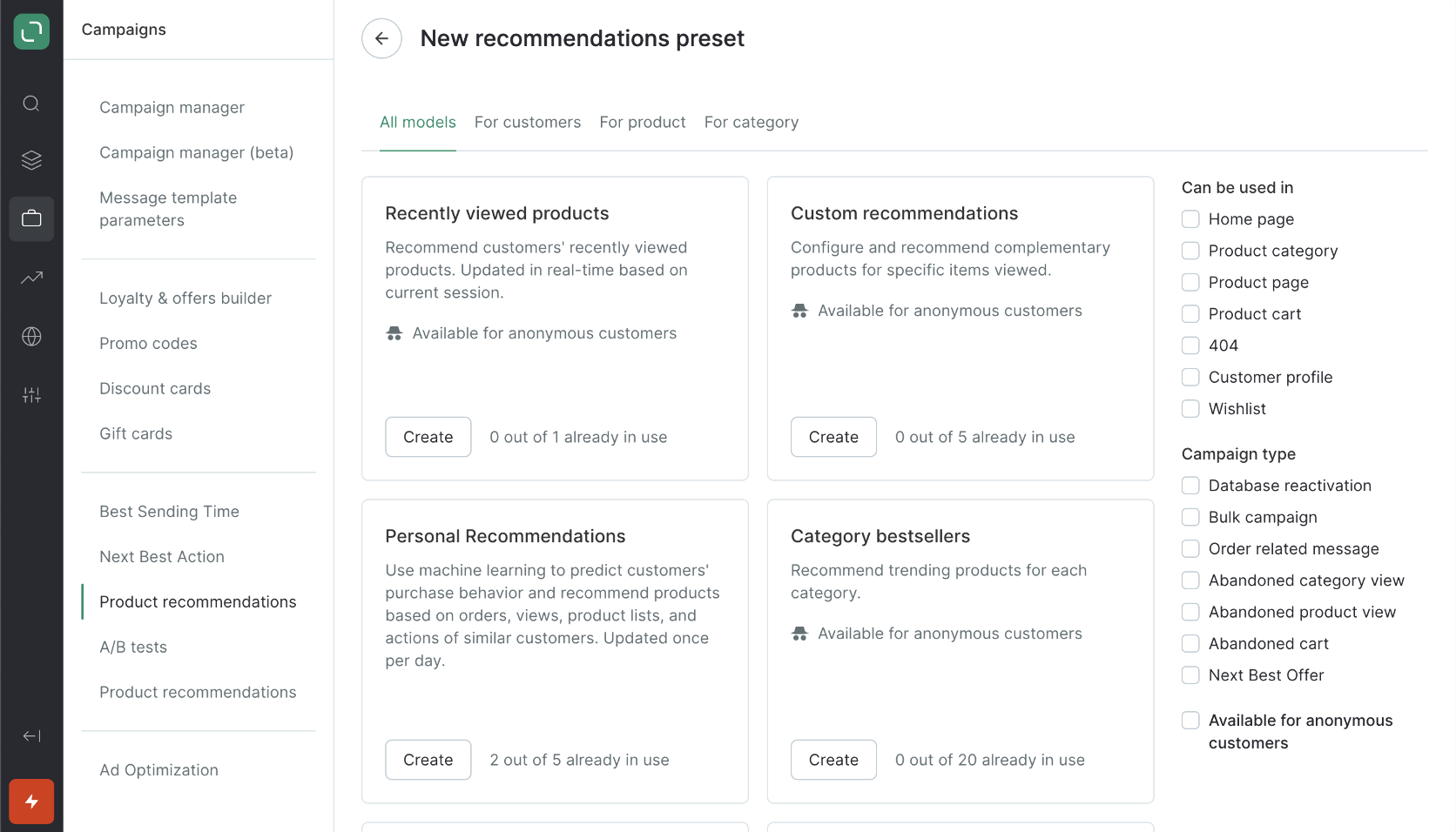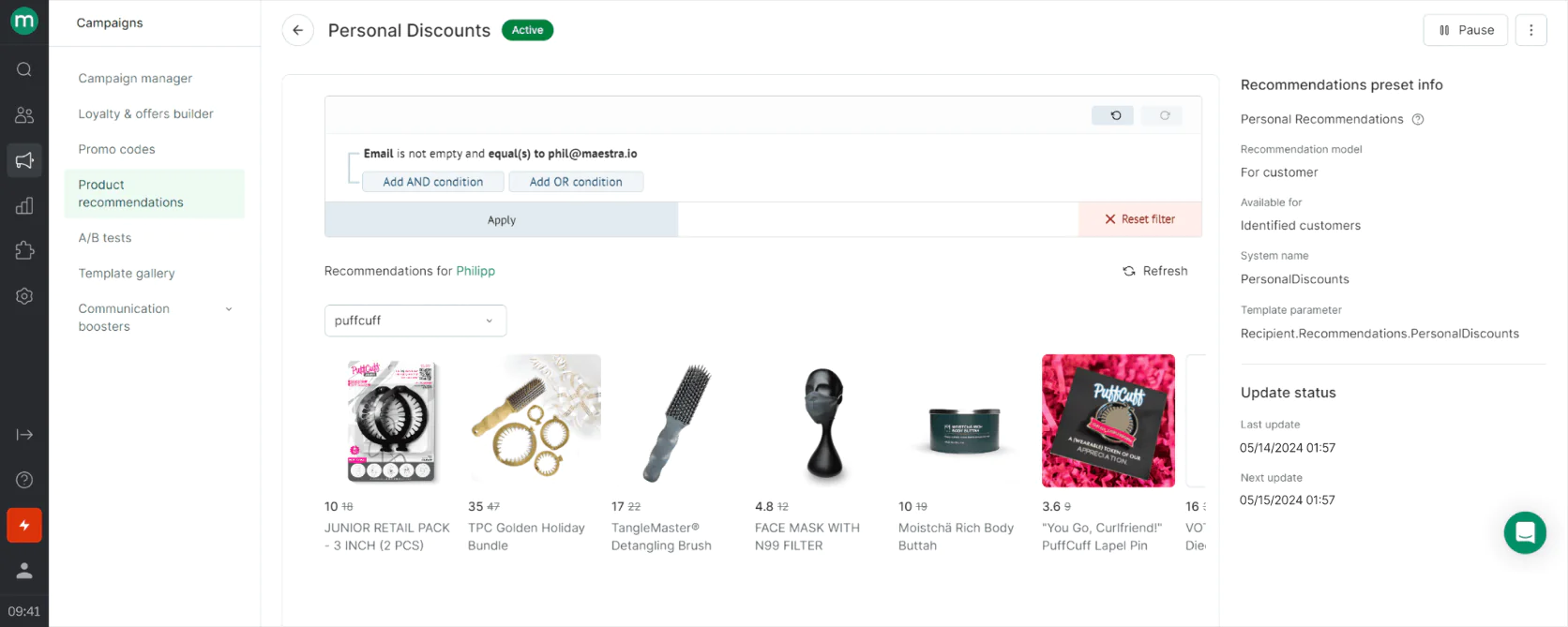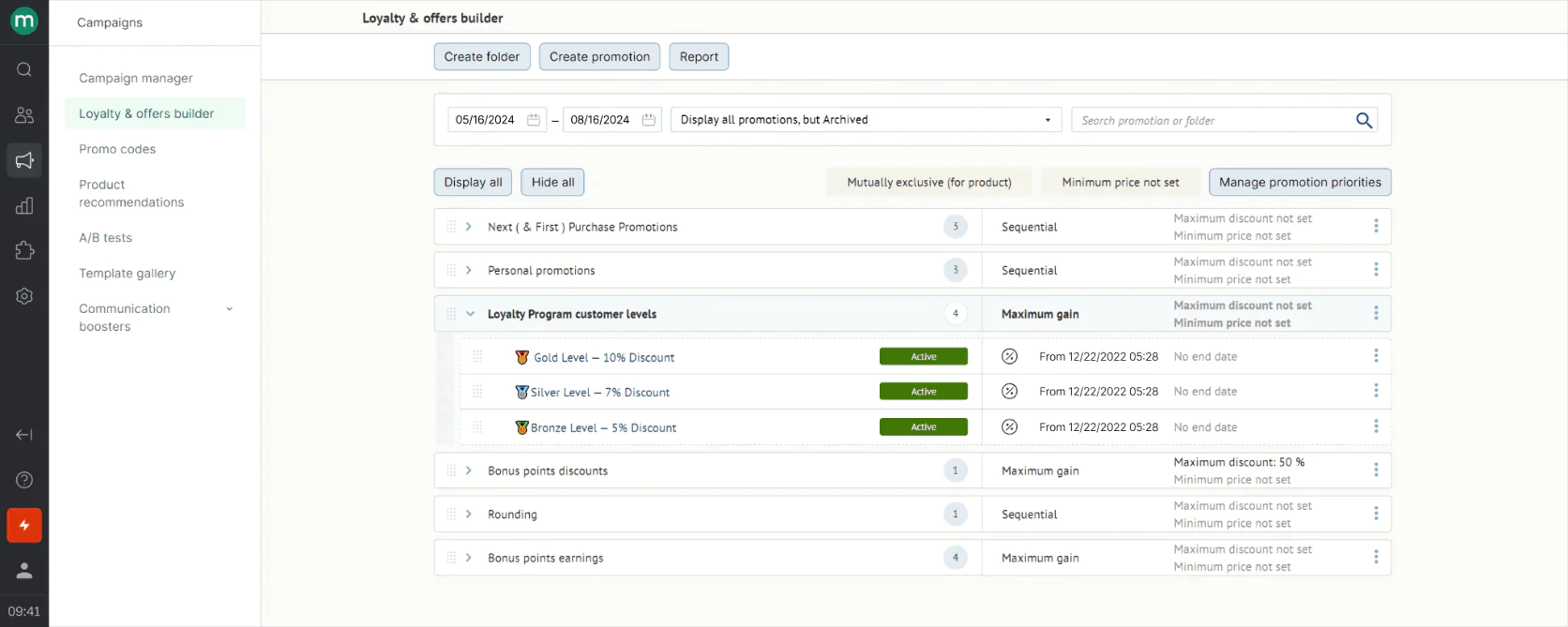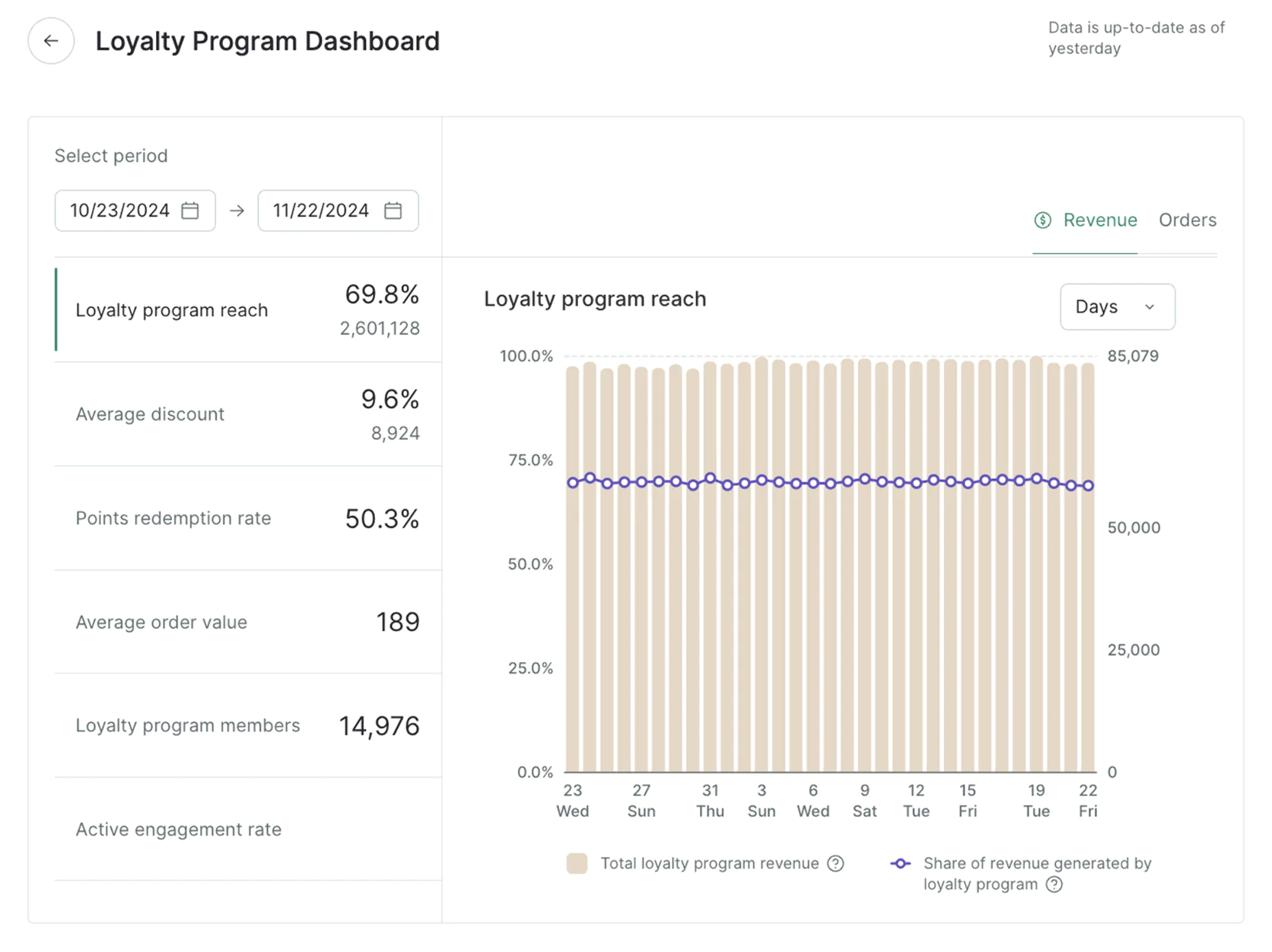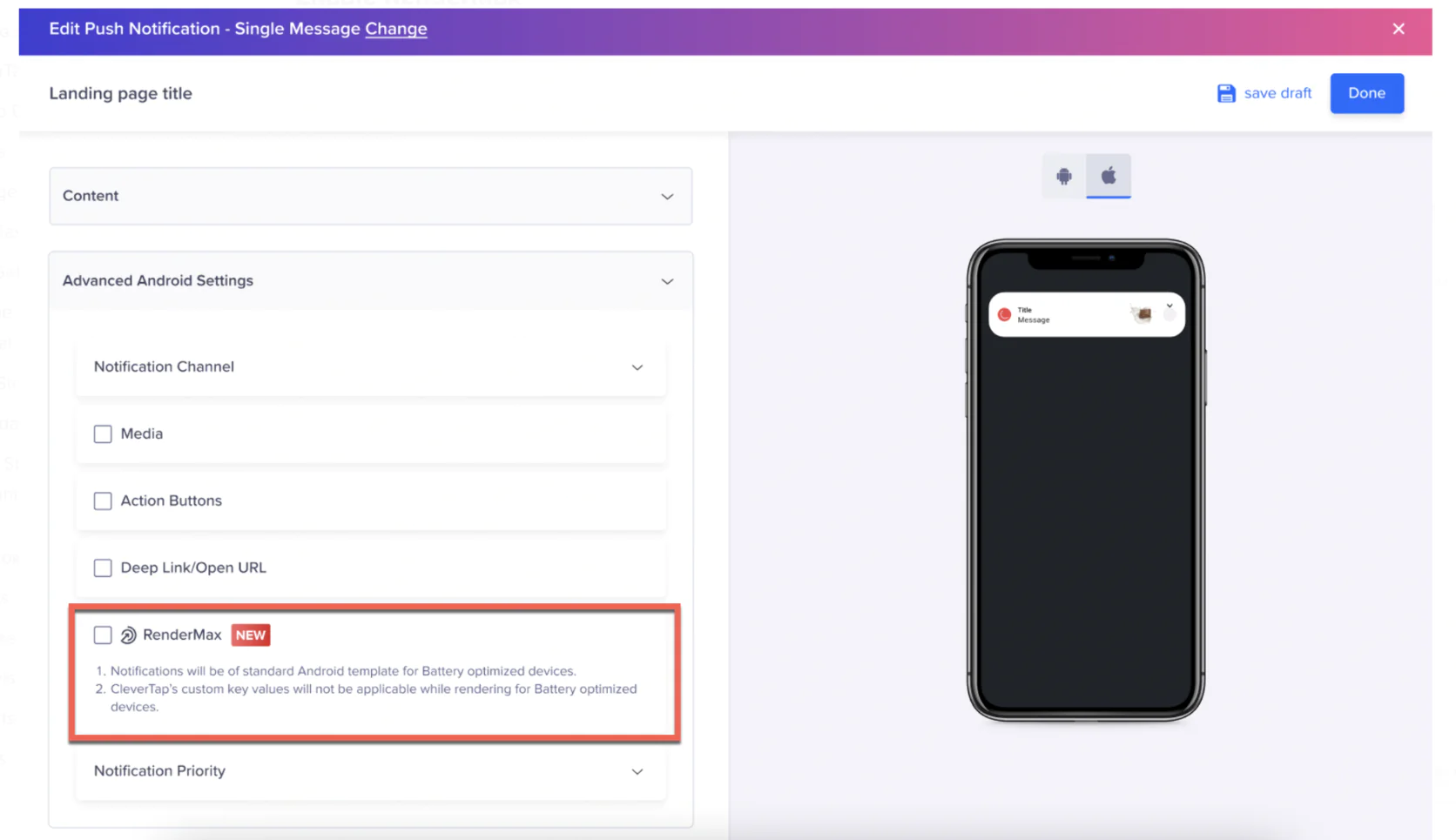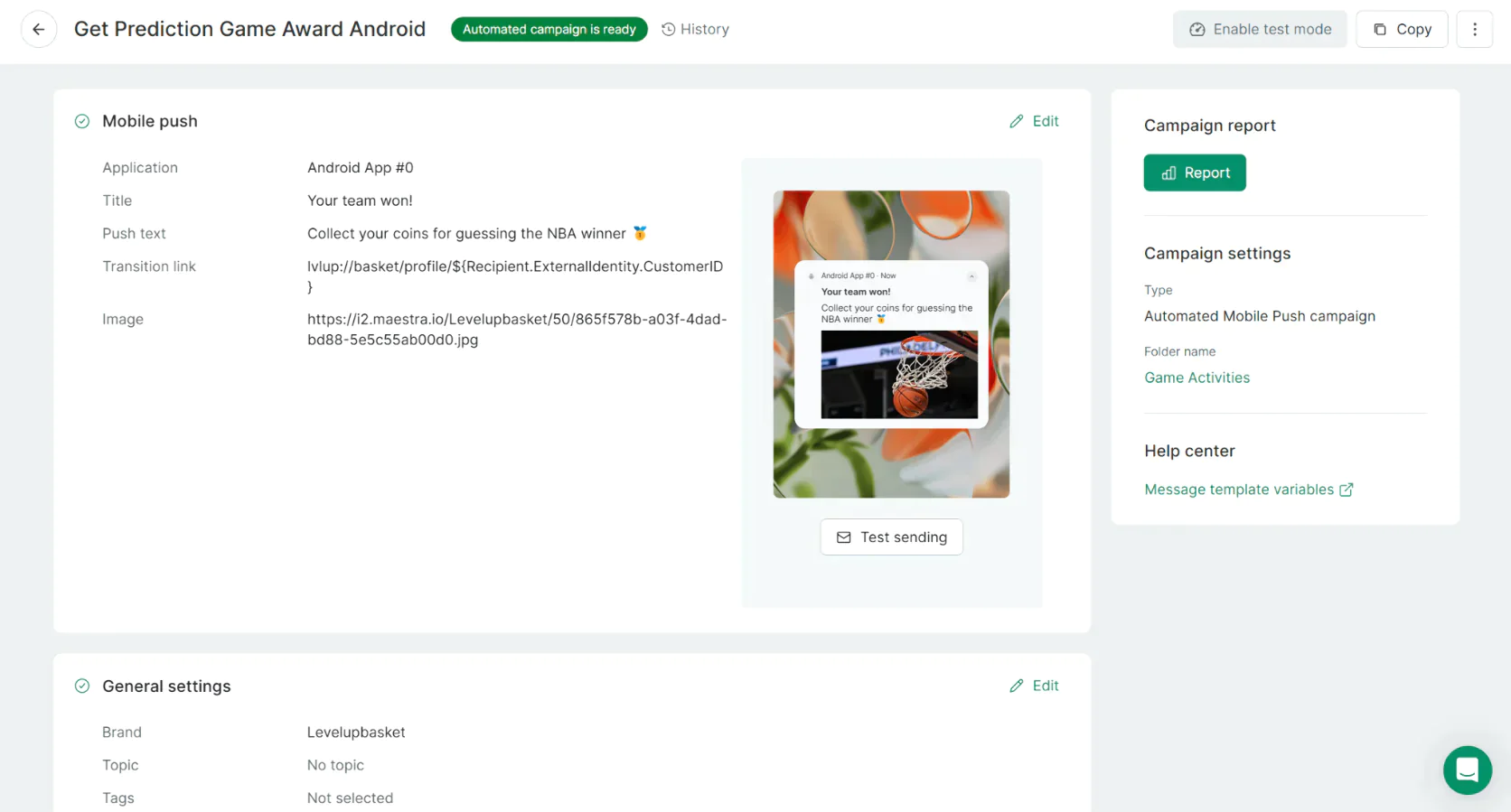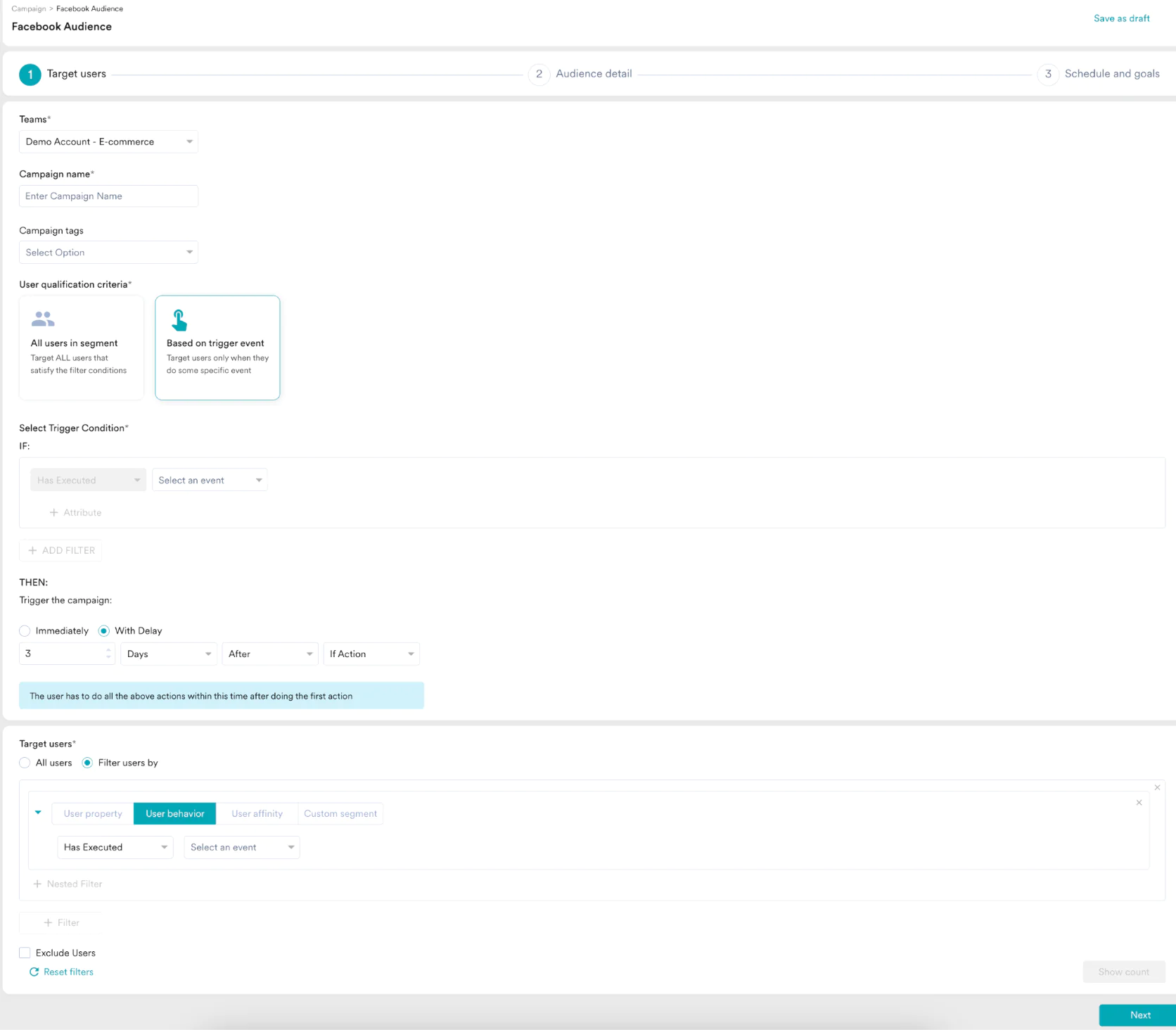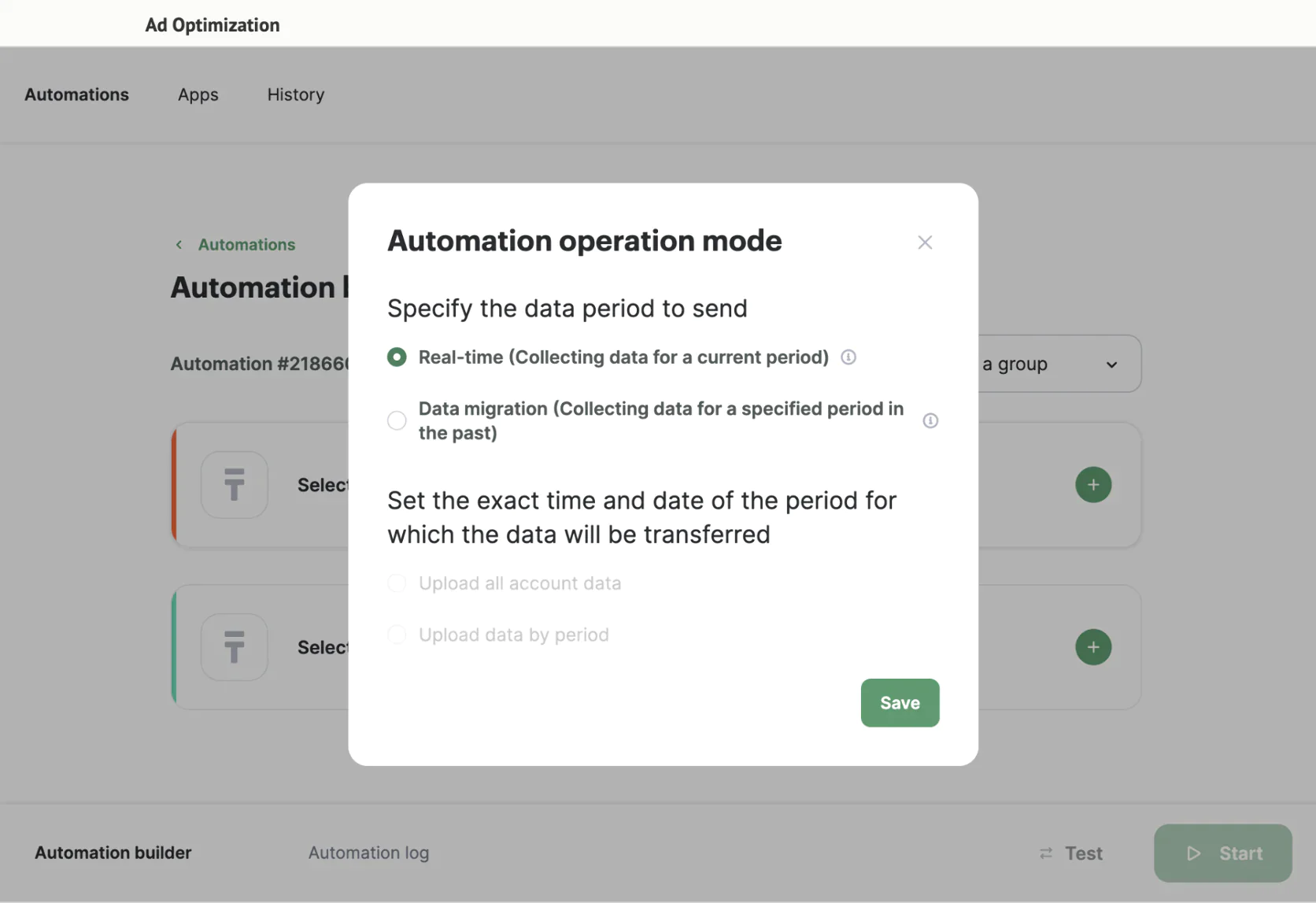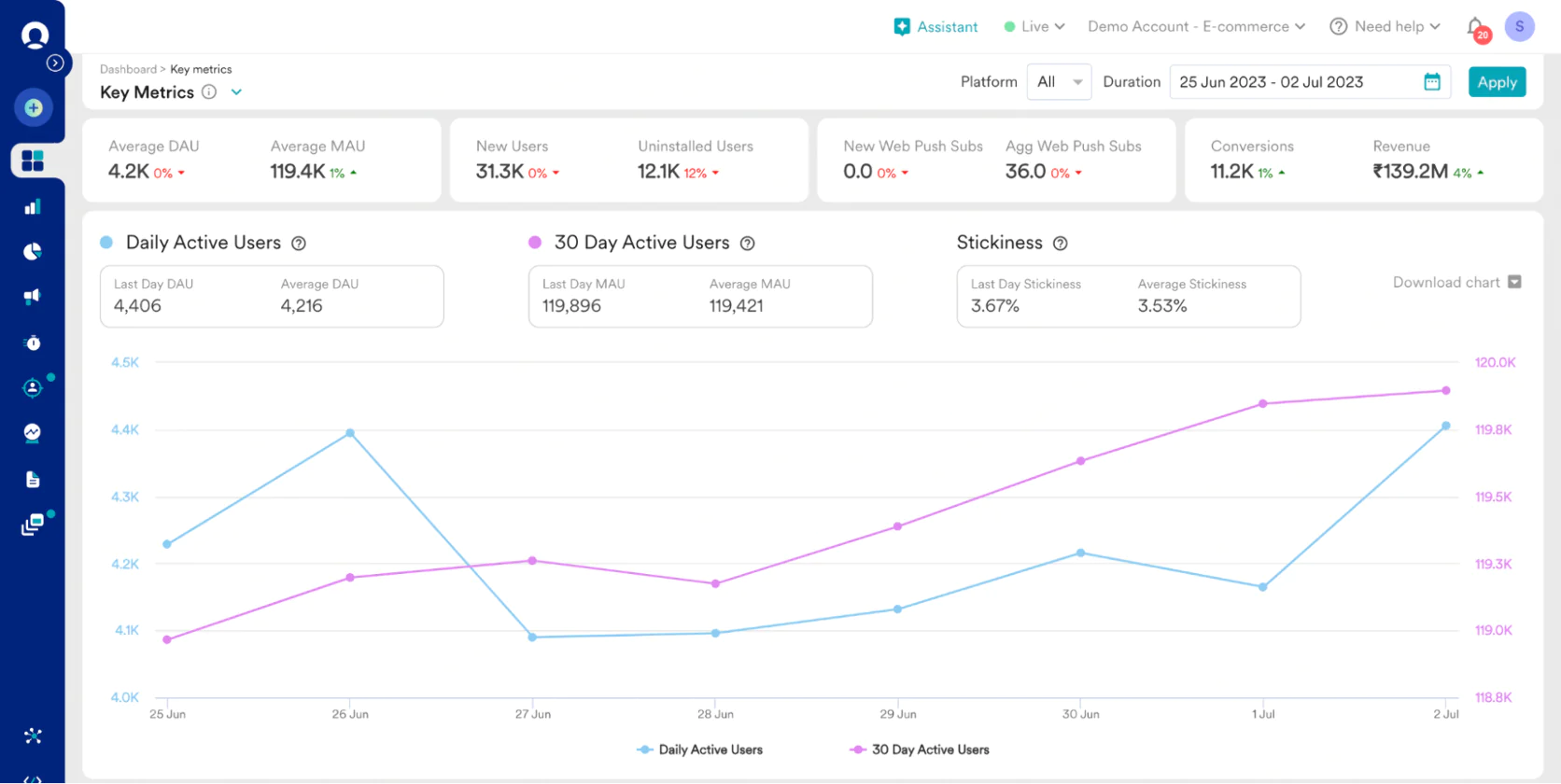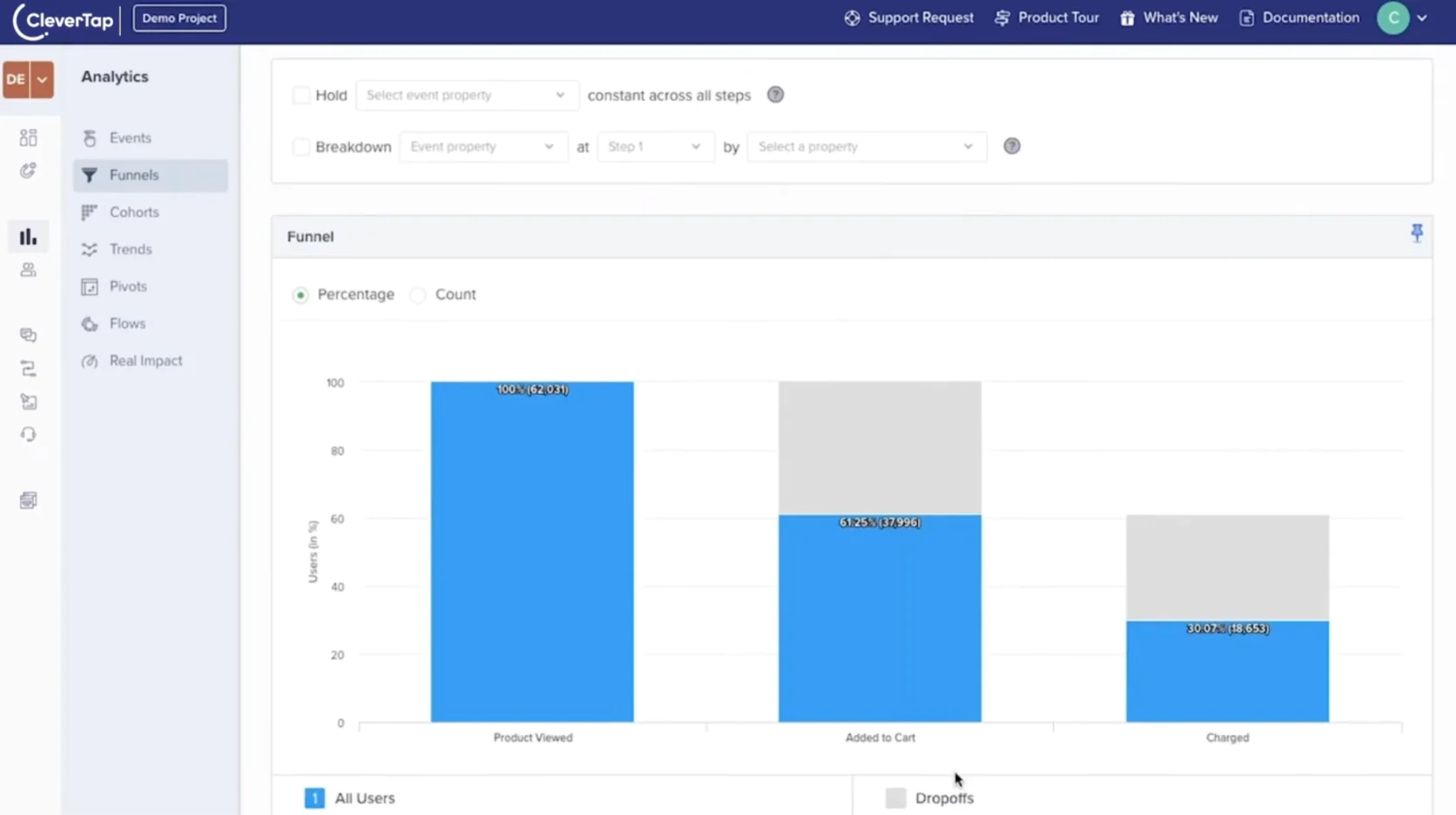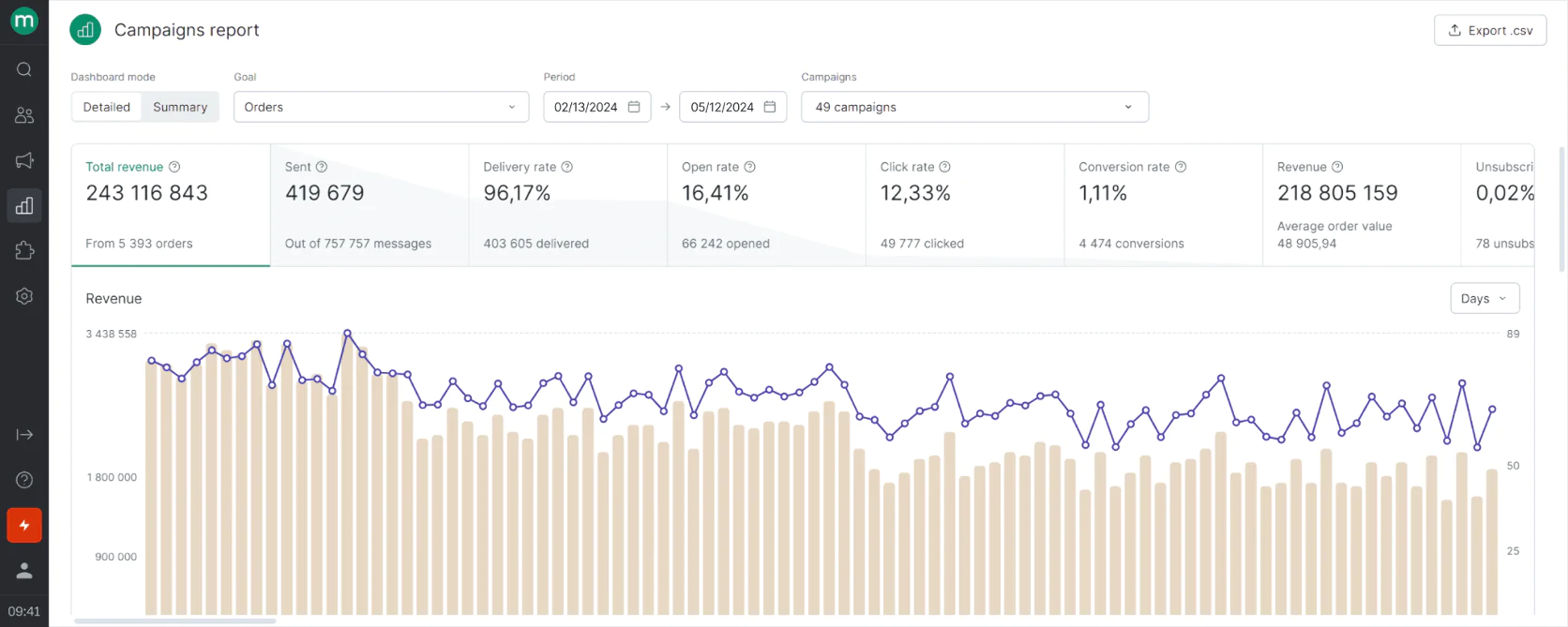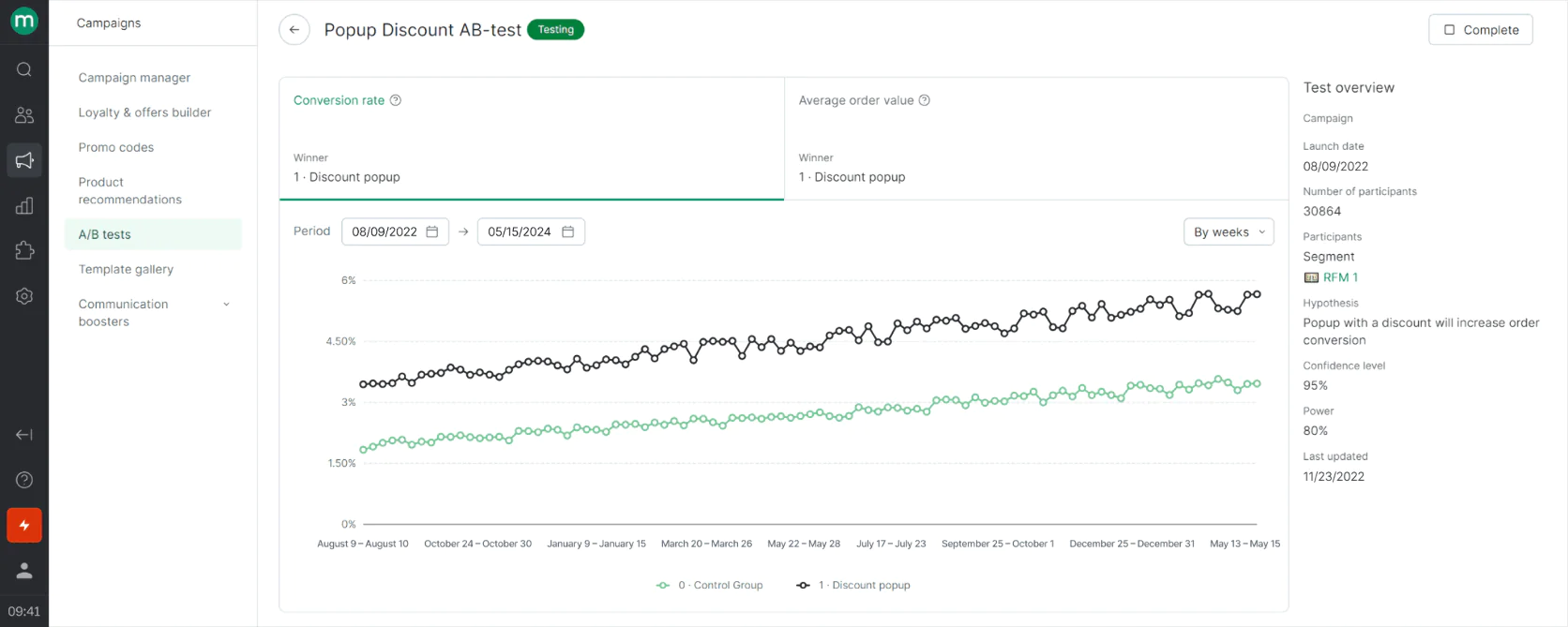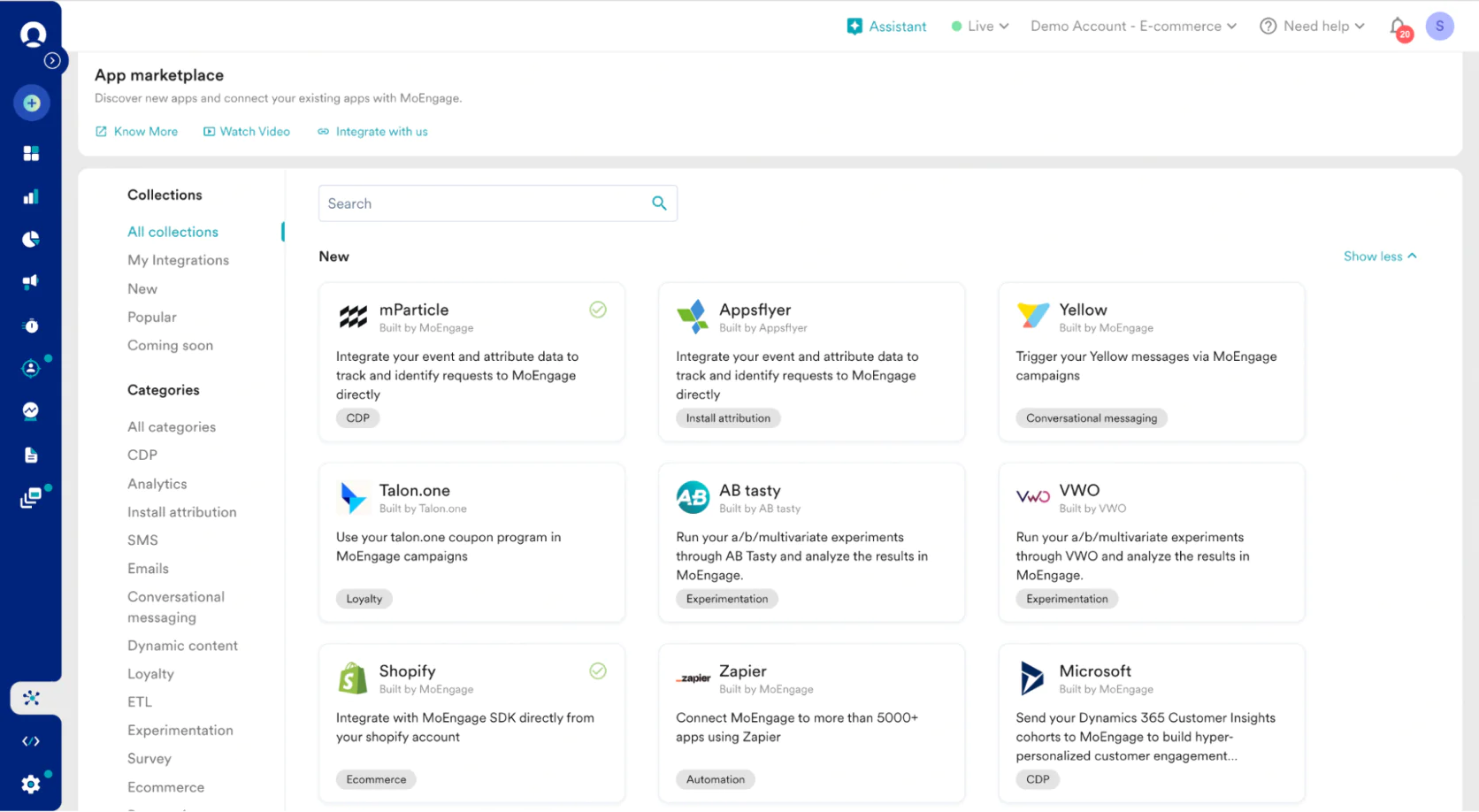MoEngage vs CleverTap vs Maestra: Finding the Ideal Omnichannel Marketing Platform for Retail
After in-depth research of MoEngage, CleverTap, and Maestra, we found that each platform excels in different areas, catering to specific business needs and use cases for e-commerce and retail marketers in the USA and Canada. Below is a quick overview of what each platform is best suited for:
MoEngage – Best for: Digital-first businesses (including startups and mobile-focused brands) seeking an insights-led customer engagement platform with strong multichannel campaign capabilities.
MoEngage’s core strength is helping marketers orchestrate campaigns across mobile and web channels with actionable analytics. It offers robust push notifications, in-app messaging, email, and SMS tools, plus AI-driven segmentation and product recommendations. However, certain advanced features (loyalty programs, complex site personalization, etc.) may require additional integrations.
CleverTap — Best for: Data-driven marketers at high-growth companies or large enterprises focused on user retention and real-time personalization at scale.
CleverTap brands itself as the world’s #1 “retention cloud,” emphasizing its ability to handle massive data volumes and instant user segmentation. It’s ideal if you need precise targeting based on deep behavioral analytics and want to optimize engagement with AI-powered features. CleverTap’s learning curve can be steeper, and like MoEngage, it doesn’t natively include loyalty or referral program management.
Maestra – Best for: Rapidly scaling brands and enterprise e-commerce retailers looking for a unified omnichannel marketing platform to drive growth through hyper-personalized promotions across all touchpoints.
Maestra is an all-in-one solution built around a real-time customer data platform (CDP) that powers email, SMS, on-site personalization, loyalty programs, product recommendations, and more – all under one roof. With white-glove support from a dedicated Customer Success Manager for every client, Maestra is perfect for teams that want advanced capabilities without needing multiple tools or extensive in-house technical resources.
In this comprehensive comparison, we’ll evaluate MoEngage vs CleverTap vs Maestra across key criteria.
Comparison Summary: MoEngage vs CleverTap vs Maestra
⭐⭐⭐⭐
Enables multi-channel journeys across email, SMS, push, in-app, and on-site messages. Has a visual journey builder for orchestrating campaigns. Lacks a built-in CDP.
⭐⭐⭐⭐
Offers advanced cross-channel automation with real-time triggers. Excels at instant event-based messaging. Relies on external data sources for some channels (no native offline / point-of-sale integration).
🏆
⭐⭐⭐⭐⭐
Creates seamless, hyper-personalized flows that connect every channel — email, SMS, website, mobile app, offline, and ads — via a built-in real-time CDP. Companies run dozens of complex flows with no performance degradation. All channels work in concert based on live customer behavior, ensuring consistent messaging everywhere.
Customer Data Management & Segmentation
⭐⭐
Provides behavioral segmentation and analytics, but retains only ~50–150 data points per user / month by default. Historical data beyond ~3 months becomes less actionable without add-ons
⭐⭐⭐⭐
Powered by a proprietary high-performance database (TesseractDB), it ingests up to 10,000 user data points per user per month. Supports precise, real-time segmentation and long-term lookbacks (up to 10 years) for deep insights. Ideal for data-rich retention campaigns, though it’s focused on digital and app data.
🏆
⭐⭐⭐⭐⭐
Offers an integrated real-time CDP that acts as a single source of truth across online and offline channels. Supports unlimited attribute tracking and event history. Advanced segmentation features include RFM scoring, product-based and nested segments, and computed traits for ultra-granular targeting.
⭐⭐
Supports basic on-site campaigns (pop-ups, banners) and personalization via APIs, but no native web content personalization engine. Marketers can trigger modals or nudges on-site, but dynamic page content changes or in-session 1:1 personalization require custom work or additional tools.
⭐⭐
Provides web pop-ups and user surveys, and can use segments to target content, but lacks a dedicated web personalization module. Personalizing the actual page layout or product sorting isn’t out-of-the-box. Primarily focuses on messaging rather than on-site experience tweaks.
🏆
⭐⭐⭐⭐⭐
Delivers real-time site personalization that adapts content for each visitor. Marketers can visually design personalized elements — pop-ups, embedded blocks, product grids, banners, even on-page text — that change based on user behavior, location, or segment. Every click can trigger instant content adjustments, creating a highly tailored web experience.
⭐⭐⭐⭐
Includes a robust email marketing module with drag-and-drop editor and automation flows. Supports personalization tags and batch sends. Many MoEngage users praise its email analytics and deliverability, though extremely advanced email customization (e.g. AMP emails) may be limited.
⭐⭐⭐⭐
Offers a full-featured email platform: drag-and-drop / HTML editor (with AMP support) for dynamic content, AI-driven send-time optimization, and multivariate testing. Its real-time segmentation means emails can target users based on up-to-the-moment behavior. Slightly higher learning curve, but very powerful.
🏆
⭐⭐⭐⭐⭐
Features a proprietary email composer built for deliverability and personalization. Supports granular trigger and bulk campaign control, and dynamic content blocks that auto-populate per segment. Leverages its CDP for 1:1 personalization (e.g. product recommendations or unique offers in emails). Advanced tools include built-in A/B testing and AMP email support for interactive content. High sending capacity (up to ~500k emails/hour) ensures it can scale with large lists.
⭐⭐⭐⭐
Allows creating automated SMS campaigns and transactional texts. MoEngage integrates with providers like Twilio, Sinch, etc., to send messages. Supports basic personalization (e.g. name, short links) and can be included in journey flows. Very advanced SMS optimization is limited.
🏆
⭐⭐⭐⭐⭐
Includes SMS as part of its omnichannel toolkit. Brands can send personalized SMS at scale and trigger texts based on user actions. Real-time engine ensures SMS triggers fire without delay. It provides analytics on SMS performance and can reward SMS subscribers.
🏆
⭐⭐⭐⭐⭐
Natively integrated SMS channel that’s part of Maestra’s unified flow builder. Marketers can send bulk or one-to-one texts with high throughput (up to 250,000 messages/hour) and track clicks via automatic URL shorteners. SMS works in tandem with other channels. Advanced features include A/B testing and cross-device tracking to avoid redundant messages.
Website and Email Product Recommendations
🏆
⭐⭐⭐⭐⭐
Provides Smart Recommendations using MoEngage’s AI engine Sherpa. Marketers can configure models like trending items, similar products, or “frequently bought together, ” and insert these recommendations into emails, push, or on-site widgets. This adds Amazon-grade recommendation algorithms to campaigns.
⭐⭐⭐⭐
Offers personalized product and content recommendation capabilities that can be used in campaigns. Recommendations can populate in emails, push notifications, etc. Effective, setting up the catalog and recommendation logic may require some technical work.
🏆
⭐⭐⭐⭐⭐
Incorporates an AI-driven recommendation engine for both web and email that works out-of-the-box. Maestra analyzes each shopper’s behavior to predict the best products to show. It supports 14 pre-built algorithms (e.g. upsell, cross-sell, new arrivals, bestsellers) and also allows custom rule-based recommendations for fine control. Recommendations update in real time — if a product goes out of stock or a user’s behavior shifts, Maestra will instantly adjust the suggestions. These can be embedded on-site or into any communications with minimal setup.
⭐⭐
No built-in loyalty points or referral program module. Marketers can still send coupon codes or sale announcements via MoEngage, but the platform doesn’t manage reward logic or referral tracking natively.
⭐⭐
No native referral or loyalty program management. CleverTap can support promotions by leveraging its segmentation, but it doesn’t provide an out-of-the-box referral scheme or promo code management.
🏆
⭐⭐⭐⭐⭐
Includes a flexible Promotions engine and built-in Refer-a-Friend system. Marketers can create time-bound offers, unique coupon codes, and referral incentives directly in Maestra. Promotions can be tailored to segments or behaviors and are automatically synced across channels. Maestra can generate referral links or codes and credit rewards (points, discounts) to the referrer when criteria are met.
⭐
Not provided natively. Retailers would need a separate loyalty platform and then use MoEngage purely to communicate loyalty updates.
⭐
Not provided natively. You can record loyalty-related events (like “Points Earned” or “Tier Reached”) and segment users by those attributes to send personalized messages.
🏆
⭐⭐⭐⭐⭐
Fully featured loyalty program module built in. Maestra lets you implement points-based rewards, VIP tiers, and loyalty-driven campaigns without extra tools. You can define how customers earn and redeem points, set up tier thresholds and perks, and even trigger omnichannel flows based on loyalty status. Loyalty data is part of Maestra’s CDP, so it can be used to personalize all other channels in real time.
Mobile and Web Push Notifications
⭐⭐⭐⭐
Excellent for mobile push — MoEngage has a strong heritage in push notifications. It ensures reliable delivery to iOS and Android apps and supports rich pushes (images, action buttons). It also offers web push for browsers and on-site notifications. Provides standard features like scheduling, throttling, and push A/B testing.
🏆
⭐⭐⭐⭐⭐
Industry-leading push capabilities. CleverTap’s RenderMax™ technology is known to achieve 90%+ push render rates even in low-power device modes, giving it an edge in ensuring messages aren’t just delivered but actually seen. It supports rich media pushes, personalization, and has advanced push amplification techniques. Web push is also supported.
⭐⭐⭐⭐
Provides customizable mobile and web push as part of its omnichannel suite. Marketers can craft push campaigns with images, emojis, and deep links, targeting users based on behaviors or segments. Maestra’s push integrates with its CDP — e.g. you can send a push when an item a user viewed drops in price. Covers the essentials well: scheduling, segment targeting, and performance tracking. It’s a one-stop solution for push alongside other channels, which is convenient.
Ad Optimization (Paid Media)
⭐⭐⭐⭐
Integrates with major ad platforms to enhance retargeting. Connectors sync segments with Facebook Ads, Google Ads, etc., allowing you to create custom audiences for lookalike or retargeting campaigns. It can also trigger ads as part of a journey. This helps reduce ad spend waste by targeting precise segments in ads.
⭐⭐⭐⭐
Provides integrations for advertising: you can connect CleverTap to Facebook and Google Ads to export user segments for retargeting. Additionally, CleverTap’s analytics can import cost and campaign data back from those platforms. Using its rich user data, marketers can optimize ad spend by focusing on high-LTV segments.
🏆
⭐⭐⭐⭐⭐
Goes beyond by combining paid media into the omnichannel flow. Maestra not only syncs audiences to Facebook, Google, and other ad networks; it can trigger ads in real time based on user actions. Because Maestra captures leads from social ads (Facebook Lead Forms, etc.) directly into its CDP, it closes the loop by immediately entering those new leads into personalized flows. The platform’s unified data means ad campaigns can be highly targeted and budget-efficient.
Reporting and Attribution
⭐⭐⭐⭐
Offers comprehensive campaign analytics and funnel reports. MoEngage’s dashboards track metrics like campaign delivery, open and click rates, conversions, and revenue attribution (via conversion goals within campaigns). You can export data and even use its APIs to feed a BI tool. While robust, MoEngage’s out-of-the-box reports focus mainly on engagement metrics; truly advanced attribution modeling may require external analytics tools.
⭐⭐⭐⭐
Provides rich analytics for each of its product areas — cohort retention reports, funnel analyses, revenue charts, etc. CleverTap is known for its uninstall tracking and retention graphs, which help pinpoint where users drop off. It also tracks the impact of campaigns on user actions and can do control group holdouts to measure lift. For attribution, it can ingest install / referral source data and attribute down-funnel conversions to campaigns. It covers most needs, though complex multi-channel attribution might still need a dedicated tool.
🏆
⭐⭐⭐⭐⭐
Maestra combines analytics across all channels in one place. You get dashboards for revenue influenced by marketing, loyalty program performance, attribution of sales to each channel, and even comparisons to industry benchmarks (e.g. email open rates vs industry average). It supports A/B test analysis and has goal-based reporting — for example, tracking how a promotion impacted 7-day repeat purchase rate. Because every touchpoint is connected, Maestra can credit the right channel or sequence of channels for a conversion (giving a more holistic view of what’s driving sales). Reports are exportable in CSV or via API for deeper analysis.
⭐⭐⭐
Offers standard support channels. All MoEngage customers can access a knowledge base and email support; higher-tier plans include faster response SLAs and possibly a dedicated account manager. Users appreciate MoEngage’s support overall but note that the level of hands-on guidance may depend on your plan and region. . Support is solid, but more “do-it-yourself” for smaller clients.
⭐⭐⭐
Provides email and chat support to all customers and assigns an account manager to enterprise accounts. Mid-tier clients might not get the same level of proactive support as Maestra offers. The platform’s complexity means you might rely on documentation and self-learning (CleverTap University) unless you’re a top-tier client.
🏆
⭐⭐⭐⭐⭐
Includes end-to-end “white glove” support for every client, regardless of size. Maestra assigns a dedicated Customer Success Manager who essentially becomes an extension of your team. This CSM assists with everything from onboarding, data migration, to ongoing campaign strategy and even custom integrations. The support is highly proactive — weekly check-ins, strategy workshops, and under 5-minute live chat response times are standard.
⭐⭐⭐⭐
Integrates with a wide range of third-party tools via its App Marketplace and APIs. MoEngage offers +100 pre-built integrations (for e-commerce platforms, email/SMS gateways, analytics, helpdesks, etc.) and supports webhook-based custom integrations. Integration breadth is strong, but building custom connections might require developer time.
⭐⭐⭐⭐
Boasts an extensive integration ecosystem. CleverTap connects with popular analytics tools (Amplitude, Google Analytics), CRMs, data warehouses, and marketing tools. It has an API and supports importing and exporting data in batch or stream. One gap: because CleverTap is more focused on mobile, some e-commerce platform plugins might be fewer than MoEngage’s.
🏆
⭐⭐⭐⭐⭐
Designed to be a hub in your stack — Maestra comes with ready connectors for major e-commerce platforms (Shopify Plus, Magento), email and SMS gateways, review apps, and more. Critically, if you need an integration that isn’t out-of-the-box, Maestra’s team will help build it for you (leveraging their open API and webhooks). Maestra monitors integrations to ensure data flows smoothly and will troubleshoot any third-party connection issues on your behalf.
⭐⭐⭐⭐
Provides a wealth of self-serve resources. MoEngage’s #GROWTH Academy and online documentation library offer courses, guides, and how-tos on customer engagement. They also host webinars and publish industry benchmark reports. The trade-off: you need to invest time in consuming these materials; hands-on training depends on your success plan.
⭐⭐⭐⭐
Offers extensive learning materials as well. CleverTap University provides structured training modules for customers, and their help center includes technical docs and best-practice guides. The CleverTap blog is another rich resource for marketers, covering trends and strategies. Given the platform’s depth, many users take advantage of these resources to climb the learning curve.
🏆
⭐⭐⭐⭐⭐
Provides tailored education and on-demand guidance. Instead of just static courses, Maestra’s philosophy is to educate clients through direct collaboration. The dedicated CSM conducts training sessions, strategy reviews, and shares best practices customized to your business. Maestra does maintain documentation and a blog, but the standout is that busy marketing leaders can rely on their CSM to keep them informed of new features, propose optimizations, and even train new team members.
Offers flexible pricing suited for various business sizes. MoEngage has a free tier (up to 10,000 monthly tracked users) which is great for small startups to try the platform. Paid plans then scale based on usage (number of users or events) and add-on features. This makes MoEngage accessible for mid-sized businesses and scalable to enterprise, but costs can rise as your user base grows.
Uses a module-based pricing — each product (push/Email, SMS, Analytics, etc.) can be licensed, or you can get an all-in-one package. The entry plan (Essentials) starts around $75/month, but full-suite deployments for large user bases can run into thousands per month. CleverTap tends to be favored by larger companies that can invest in a premium solution. It may be less budget-friendly for a small business.
Employs profile-based pricing with all key features included. Maestra’s plans start at around $2,990/month for up to 80,000 customers (profiles). While the starting price is higher than MoEngage’s or CleverTap’s base plans, it includes unlimited use of email, push, on-site personalization, loyalty, and full support — essentially, an entire marketing stack and team. There are no separate module fees; you pay based on the size of your customer database and usage of messages (SMS has a low per-text fee of ~$0.0045). As you grow, the cost per profile tends to be lower than piecing together multiple tools, making Maestra cost-efficient for retailers who leverage its all-in-one nature.
MoEngage vs CleverTap vs Maestra: Omnichannel Flows
MoEngage enables marketers to design multi-channel journeys using a visual workflow editor (Flows). You can set up triggers and branching logic — for example, if a user doesn’t click an email, then send an SMS one day later, then perhaps a push notification. This allows consistent messaging on different channels.
However, MoEngage lacks a built-in customer data platform, which means data from outside sources (like in-store purchases or certain web behaviors) might not feed into the flows unless you integrate those systems. It supports the main digital channels well (including email, SMS, mobile/web push, in-app messages, and on-site pop-ups). Users often praise MoEngage’s journey builder for its ease of use, but note that achieving true 1-to-1 omnichannel personalization can be challenging without additional data unification.
Overall, MoEngage covers all key channels and automation, but it depends on third-party data platforms for deeper unity.
CleverTap also offers omnichannel campaign orchestration and shines in real-time responsiveness. Its Journeys feature lets you target users across push, in-app, email, SMS, and more, reacting instantly to user actions.
A standout point is CleverTap’s ability to handle event triggers in real time – for instance, if a customer browses a product and doesn’t purchase, CleverTap could send a push or email offer minutes later while the interest is hot.
Like MoEngage, it lacks an integrated offline data ingest out-of-the-box; you would integrate your CRM or POS data via API if needed. But for digital touchpoints, it’s very strong.
CleverTap is technically robust, yet it similarly assumes that the marketer will bring together any external data (e.g., loyalty status) themselves.
Maestra’s approach to omnichannel flows is to have everything in one place. Its flow builder uses the unified customer profile (in the CDP) to determine the path for each user in real time. This means a flow can seamlessly incorporate, say, an email → then an SMS → then a site personalization → then a Facebook Ad, all orchestrated and aware of each other.
Maestra’s flow example: abandoned card flow with emails, mobile and web pushes, pop-ups, paid ads and loyalty points
For example, a customer who abandoned a cart might get a reminder email; if they still don’t buy, Maestra could automatically include them in a Facebook retargeting ad audience and send a mobile push notification with a coupon – all as part of one coordinated sequence. Because Maestra tracks offline and online events together, even an in-store purchase could trigger ending the online sequence (to avoid sending a needless coupon).
It creates hyper-personalized, cross-channel conversations at scale, which is ideal for mid-sized retailers that want enterprise-level orchestration. Companies have reportedly built +90 active flows in Maestra without performance issues, illustrating its scalability.
Omnichannel Flows Winner: Maestra
While MoEngage and CleverTap both capably handle multi-channel marketing automation, Maestra delivers a more unified experience thanks to its built-in CDP and breadth of channels (including some tools and channels the others lack, like loyalty and point-of-sale integration).
For a retailer aiming to create seamless customer journeys (online to offline, and vice versa), Maestra provides out-of-the-box capabilities that would otherwise require stitching together several tools. That said, businesses that primarily operate in the digital realm (app and website) could still succeed with MoEngage or CleverTap’s omnichannel tools, especially if they have the technical support to integrate additional data sources.
MoEngage vs CleverTap vs Maestra: Customer Data Management & Segmentation
MoEngage: MoEngage includes a customer profiles database that tracks user attributes and events (like app launches, product views, purchases, etc.). Marketers can create segments using these data – for example, “Users who viewed product X in the last 7 days and have not purchased in 30 days.”
Creating a segment in MoEngage
However, data-retention limitations in MoEngage mean that by default it only keeps a few months of granular behavioral data readily available for segmentation. In fact, MoEngage retains roughly 50–150 data points per user per month and only guarantees real-time segmentation on recent data (past 30 days). Extending beyond that requires purchasing add-ons and even then the older data become “read-only” for analytics (not actionable in campaigns).This can be a drawback for long-term customer-journey mapping or re-engagement campaigns (e.g., finding users who bought 6 months ago to re-target might be harder if that event is archived).
Segmentation UI in MoEngage is user-friendly for basic needs – you can combine filters on demographics, behavior, location, etc. It also supports predictive segments (their Sherpa AI can create segments like “likely to churn” vs “likely to purchase” users).
Overall, MoEngage is not a full CDP. It’s sufficient for many use cases, but it doesn’t offer the depth or single-customer-view that modern personalized marketing often demands.
CleverTap really differentiates in data management among these three. It’s built with a proprietary TesseractDB which is optimized for customer-event data. CleverTap can ingest up to 10,000 events per user per month and keep all of them actionable for segmentation for up to 10 years.
This means marketers can create incredibly granular segments, even using long-term behavior trends. For example, you could segment “Users who made a purchase during holiday season in each of the last 3 years but not this year.” Every data point captured (clicks, views, transactions, etc.) can be used to filter users.
CleverTap also updates segments in real time – their system streams events so users enter or exit segments immediately as their behavior changes. This is crucial for timely campaigns (no waiting for a nightly batch update).
In practice, CleverTap’s segmentation capabilities allow for precise targeting: you can combine properties (like “in Canada” AND “VIP tier” AND “opened app ≥ 5 times this week” AND “not purchased in 30 days”) and it computes fast, even with millions of users.
The platform also uses RFM (recency, frequency, monetary) analysis and AI to predict things like churn or conversion likelihood, which helps in building strategic segments automatically.
CleverTap is extremely powerful for what it’s built to do (hence widely used in mobile-first industries for retention marketing). But it’s focused on digital behaviors (app and web) and doesn’t inherently unify offline data unless you feed it in.
Maestra includes a full Customer Data Platform (CDP) at its core. This means it is designed to intake data from all sources – your e-commerce platform, point-of-sale, email interactions, loyalty program, etc. – and merge them into one profile per customer.
For a retail marketer, this single view is gold. For example, Maestra can show that Jane Doe clicked a Facebook ad, joined via a pop-up on the website, made her first purchase in-store, later browsed the website on mobile, and has 1,200 loyalty points – all in one timeline.
Importantly, Maestra’s data updating is real-time and its segmentation capabilities are very advanced. It supports nested segmentation (segments within segments) and exclusion logic (e.g., segment of “Women’s footwear shoppers” minus those “Already bought boots this season”). It also has computed traits – essentially allowing custom metrics or flags (like “High Spender” could be a computed attribute if spend > X in last 90 days). And segments update immediately as data comes in.
Maestra: user segmentation
There is also RFM segmentation built-in, which automatically groups customers by their purchase recency, frequency, and monetary value – a common need for retail CRM.
RFM segmentation in Maestra
All of this runs in a system built specifically for commerce, which Maestra offers enterprise-grade scalability with quick implementation time. Because Maestra acts as a CDP, marketers appreciate not having to invest in a separate data platform for privacy compliance and first-party data control — Maestra becomes that central repository.
Given these strengths, Maestra provides the most complete view of the customer and the most flexibility in how to slice and dice the audience for targeted campaigns.
Data Management Winner: Maestra
Maestra’s real-time CDP and rich segmentation toolkit make it the leader in leveraging customer data across channels. Especially for retailers dealing with multiple data streams (online, in-store, loyalty, customer service), having all data unified can significantly improve personalization and marketing ROI.
CleverTap comes a close second with its impressive data throughput and real-time segmentation – it’s an excellent choice for companies that primarily need to maximize app engagement with large data volumes.
MoEngage is reliable for basic segmentation but may require augmentation (like an external data warehouse or CDP) as a company grows and wants to incorporate more data or look at longer customer lifecycles.
MoEngage vs CleverTap vs Maestra: Site Personalization
MoEngage: MoEngage does not offer a dedicated on-site personalization module that can, for example, swap out page content on the fly for different users.
What it does offer are on-site messaging tools: you can deploy pop-up modals, notification bars, slide-in offers, etc., based on user behavior. For instance, using MoEngage, a marketer can set a rule to show a 10% off pop-up when a user is about to exit the site (detected by mouse movement) or after 3 pageviews. These are effective for lead capture or promoting offers. You can also personalize those pop-ups with user data (like inserting the user’s first name or recommending a product category they browsed) to some extent.
Popup editing in MoEngage
However, if you want to do deeper personalization like rearranging the homepage content depending on whether the visitor is a repeat customer vs new, MoEngage by itself doesn’t do that – you’d need to have your web developers use MoEngage’s data (it can export segments or user attributes) to custom-code such experiences.
MoEngage’s strength lies more in messaging than in modifying the core site UI for each user.
CleverTap: CleverTap is similar to MoEngage in that it wasn’t primarily built as a web personalization engine. It focuses on messaging channels and in-app experiences.
For websites, CleverTap provides Web Pop-ups and Surveys as part of its Web Messaging features. You can target these to specific segments (thanks to CleverTap’s segmentation) – e.g., show a special promo banner only to users coming from a certain ad campaign or only to users who have high lifetime value.
Creating a pop-up in CleverTap
Moreover, if you integrate CleverTap into your website, it can track user actions and then you could use that data to tailor some content (again, likely via custom code).
In summary, CleverTap offers targeted on-site engagements (pop-ups, notifications) but not drag-and-drop page personalization.
Maestra: Maestra was built with the notion that your website should be as dynamic as your emails.
It provides a Real-time Site Personalization module that lets non-technical marketers change on-site content based on user data, all through a visual editor. For example, you can design an embedded content block that says “Recommended for you, Jane” with products tailored to Jane’s browsing history, and Maestra will display it only to Jane (and each user sees their own recommendations).
You can create personalization rules: if the user is in segment “VIP Customers”, show a VIP banner on the homepage; if the user’s city (geo-ip) is New York, show them a “NYC Winter Sale” hero image, whereas a user from Miami might see a different image.
All of this is done without needing engineering – Maestra’s interface allows you to insert and swap such content.
Maestra’s pop-up template editing
Additionally, Maestra supports various interactive on-site elements to engage users: quizzes, games, surveys, stories (like Instagram-style stories on your site). These not only personalize the experience but also capture more data (which feeds back into the CDP).
Product-picking quiz powered by Maestra
Crucially, Maestra’s personalization reacts in real time; if a user’s behavior changes mid-session (say they start viewing a new category), Maestra can switch the recommendation widget to that category on the fly.
It also has built-in controls to avoid overdoing it – frequency capping and prioritization so the user isn’t bombarded with too many pop-ups.
Maestra offers a comprehensive and marketer-friendly solution for site personalization. It’s a rare capability especially among tools focusing on mid-market — usually you’d need enterprise suites or separate personalization software.
Site Personalization Winner: Maestra
Maestra clearly leads by allowing retailers to personalize web experiences easily and in real time. For e-commerce brands, where conversion rate optimization is paramount, being able to tailor your site per visitor (and run experiments with those personalized elements) is a big competitive advantage.
MoEngage and CleverTap can support some on-site personalization through pop-ups and by leveraging their data with custom work, but they don’t come close to the out-of-the-box depth that Maestra provides in this area.
MoEngage vs CleverTap vs Maestra: Email
With MoEngage, you can create bulk email campaigns or triggered emails (for example, send a “We miss you” email when a user hasn’t opened the app or made a purchase in X days). The platform provides a drag-and-drop email editor, basic templates, personalization placeholders (insert name, etc.), and the ability to A/B test subject lines.
MoEngage also emphasizes its deliverability optimization – they have feedback loops with major email providers and offer analytics like delivery rate, open rate, click rate, and conversions from email.
MoEngage’s email features are slightly below CleverTap’s in specific areas like segmentation. For example, creating very granular segmented email campaigns is a tad easier in CleverTap (due to its data strengths).
But MoEngage’s email tool is generally robust and user-friendly, making it a great all-in-one solution if you don’t already have an ESP. It covers most needs: scheduled newsletters, automated drip series, personalization, and even some AI-based send time optimization. It’s strong, especially for an integrated platform, but there’s still a ceiling in advanced use cases (like if you wanted fully dynamic content or AMP interactive emails, you might need additional customization).
CleverTap offers a comprehensive email marketing capability as well, called CleverTap Email. It supports rich email content, including AMP Emails for interactivity, and a flexible editor supporting drag-and-drop or custom HTML.
CleverTap’s email builder
One highlight is CleverTap’s use of its data prowess to enhance email – for instance, you can create very fine-tuned segments for email campaigns (like “users who viewed product X more than twice in the last week and have high churn risk”).
Also, CleverTap has machine learning features for email: they can do things like determine the optimal time of day each user is likely to open emails, and then send accordingly (so User A gets it at 8am, User B at 7pm, based on past behavior).
Another advanced feature is IntelliNODE for multivariate testing in journeys – it can test different email paths in an automation and auto-optimize the journey.
In terms of analytics, CleverTap provides detailed dashboards for email performance and even spam diagnostics and domain reputation tracking which help marketers maintain deliverability. For senders, who often have to watch Gmail promotions tab vs inbox placement, such diagnostics are valuable.
CleverTap is arguably more advanced than MoEngage, but the complexity might require a dedicated email marketer to fully exploit. Some users mention that while powerful, the UI for creating complex email workflows can be a bit less intuitive due to the plethora of options – which is a trade-off for that power. Nonetheless, CleverTap’s email solution is on par with many standalone email marketing platforms in terms of features (and in some cases ahead, thanks to its data integration).
Maestra: Maestra’s email component is built to ensure marketing emails are both highly personalized and highly deliverable. Maestra provides a drag-and-drop editor as well, with a library of content blocks. Their emails are coded to be “clean and lean” to avoid Gmail clipping or spam flags.
Maestra’s visual email composer
What sets Maestra apart is how deeply it can personalize dynamic blocks using the CDP data. For example, you could easily configure an email template that populates a “Recommended for you” section based on each recipient’s browsing history or past purchases (drawing on Maestra’s product recommendation engine). Or include a dynamic coupon code unique to each customer, or even change language/tone depending on the customer’s segment. This level of personalization is usually a task with other platforms that might involve scripting or complex logic, but Maestra’s integration makes it more plug-and-play.
Jolyn’s personalized winback email build with Maestra's editor
Another strength is programmatic control over sending — Maestra allows setting granular rules like limiting emails to certain hours per user’s time zone, automated UTM tracking on links for attribution, and it has built-in email deliverability insights (like an Email Health dashboard that compares your open/click rates to industry benchmarks, so you know if you’re lagging).
Maestra’s email health monitoring
It also supports AMP for Email (so you can include interactive elements in emails, such as carousels or forms that work inside the email).
Sending volume is not a problem — their infrastructure can handle very large blasts (500k/hour as noted) and they include warming up your domain/IP as part of onboarding to ensure good sender reputation.
Maestra essentially gives you enterprise-grade email marketing as part of the package, without needing a separate ESP. One could argue that a dedicated platform like, say, Mailchimp or Braze’s email might have more template variety or such, but Maestra’s advantage is the tight personalization integration and service support (their team will even help design responsive email templates or troubleshoot deliverability as part of the support).
All three platforms are quite capable with email, but Maestra’s built-in advanced personalization and all-inclusive approach make it particularly strong for retailers who want to leverage rich customer data in emails. It’s effectively combining the functionality of an email service provider with a CDP.
MoEngage and CleverTap both do an admirable job – in fact, CleverTap might be preferable for teams that need very technical optimizations, especially if you have the resources to manage those features. MoEngage’s email is perfectly fine for most marketing needs and has the benefit of simplicity and a free tier (which the others don’t).
But if the goal is to have email campaigns that feel individually tailored and to squeeze the most ROI out of each send, Maestra’s capabilities and guidance edge it ahead.
MoEngage vs CleverTap vs Maestra: SMS
MoEngage: MoEngage supports SMS as a channel in its engagement toolkit. It doesn’t act as an SMS gateway itself; instead, it provides a connector to SMS service providers like Twilio, Nexmo, etc. Once that’s done, you can create SMS campaigns within MoEngage just like you would an email or push campaign. This includes scheduling bulk SMS blasts or setting up triggered SMS.
SMS campaign creation in MoEngage
MoEngage’s campaign builder allows using personalization tags in SMS too – like addressing the user by first name, or inserting a short trackable URL for a specific user. They even have a URL shortener built in so that long UTM links can be condensed to something like moengage.ly/XYZ.
From a compliance perspective, MoEngage can manage opt-out lists if you feed that data in (important in US due to TCPA regulations). There is also basic performance reporting: delivery rate, click-through if links are present, and conversion if tied to an event.
One limitation is that MoEngage’s native analytics for SMS aren’t as in-depth as for email or push – often you rely on the SMS provider for detailed logs. But from a marketer’s standpoint, being able to orchestrate SMS in the same journeys as email and push is a big plus.
MoEngage covers the bases well (automation, personalization, integration), only missing some ultra-advanced features like intelligent SMS send time or content optimization (which are rarer in SMS marketing anyway).
CleverTap integrates SMS in a very similar fashion. You’ll connect a service like Twilio or another regional SMS aggregator to send the messages.
CleverTap’s advantage is using its real-time behavior tracking to trigger SMS in a very timely manner. For example, if a user adds to cart but doesn’t purchase, CleverTap could send an SMS reminder with a link to their cart within minutes, potentially catching them while they’re still on their phone. It also can combine channels: maybe you set a journey where a push notification goes out first, and if the user doesn’t open the app from that push, then an SMS goes out a few hours later – CleverTap handles that decisioning.
SMS campaign creation in CleverTap
In markets like North America, SMS is heavily regulated and also not free, so marketers appreciate features like frequency capping (to avoid spamming too many texts) which CleverTap supports via its controls.
Also, CleverTap can incorporate MMS or WhatsApp – though WhatsApp is less prevalent in the US, some Canadian or international segments might use it. Given CleverTap’s strong event architecture, you can personalize SMS with any attribute (e.g. “Hi , that item you liked is back in stock!”). The platform records SMS responses too if you use two-way (for instance, if a user texts back, you can capture that as an event via Twilio).
CleverTap is essentially on par with MoEngage; the differentiation comes from how you utilize their data strengths (CleverTap’s fine segmentation may help you be more precise with SMS targeting, which is valuable since SMS costs per message).
Maestra integrates SMS in omnichannel flows. This means if you design a customer journey in Maestra, adding an SMS touchpoint is as easy as adding an email or push – it’s one of the nodes you can drop in the flow.
A major benefit here is that Maestra’s SMS is fully aware of other channel communications. For example, if a user received an email and clicked it, Maestra might skip the follow-up SMS; conversely, if they ignored the email, Maestra might send the SMS. This coordination can improve customer experience and reduce redundant messages. Maestra handles SMS sending at scale (up to 250k per hour as noted) which is plenty even for large campaigns.
They also support cross-device linking – so if an SMS contains a link to a promo, and the user clicks it on their phone then later opens their laptop, Maestra can recognize it’s the same person and keep their session consistent (this involves some technical magic like identity resolution across devices).
Another neat feature is ticket authentication via SMS, which can be used for things like sending a one-time passcode or unique link – basically it means they can use SMS for not just marketing but transactional verifications (useful for retail events or contests, etc.).
Reporting and optimization are there: Maestra provides A/B testing for SMS content or send time, and click tracking with shortened URLs, so you can measure engagement.
Maestra’s SMS is better woven into the overall platform. Maestra’s team guides on SMS best practices too (time of day norms for US, appropriate cadence, compliance), which for a marketer is added value beyond the software features.
All three platforms let you execute SMS campaigns effectively, but Maestra’s tight omnichannel integration and additional bells and whistles (like built-in testing and cross-device awareness) give it the edge. This means you can confidently include SMS in your automated flows without worrying about over-messaging or siloed data – Maestra will coordinate it with your other channels.
MoEngage and CleverTap are still strong choices if, for instance, you’re mainly focused on app user engagement and want SMS as a backup channel; they will get the job done, especially given their proven reliability at high scale.
However, if SMS is a key revenue driver and you want to maximize personalization and timing (which is increasingly crucial as SMS inboxes get more competitive), Maestra provides that extra level of integration to make messages count.
MoEngage vs CleverTap vs Maestra: Website and Email Product Recommendations
MoEngage introduced Smart Recommendations as part of its offering. Rather than building a recommendation engine from scratch, MoEngage Smart Recommendations leverage AWS Personalize (the same tech Amazon uses) under the hood. This is a powerful engine that can employ algorithms like collaborative filtering, popularity, item similarity, etc., on your product catalog and user behavior data.
With MoEngage, marketers can configure different recommendation strategies: for example, "Trending Products" (which uses overall popular items), "Similar Items" (looks at items similar to what the user viewed or added to cart), "Frequently Bought Together" (based on what other customers often purchase together), and more. You define these in MoEngage's dashboard by selecting the model type and any filters (like maybe recommend trending items within the user's favorite category).
Once defined, these recommendations can be inserted into emails (using placeholders that fetch recommended items for each user at send time) or shown in in-app/in-site messages.
Adding MoEngage’s recommendations into an email
However, MoEngage doesn't directly inject recommendations into your site's HTML on page load (that's more Maestra's style). Instead, you might display them via a MoEngage-powered pop-up or via your own site code calling MoEngage's API for recommendations. In email, it's seamless – MoEngage will populate the content before sending.
The efficacy of MoEngage's recommendations is quite high given the Amazon AI backbone; it's a strong add-on for retailers who want to quickly get recommendation capability without implementing a separate system. But it's not a fully native part of the web experience without some integration.
Historically, CleverTap focused on engagement rather than content recommendation. But it has evolved, and now CleverTap does have a Recommendations framework. Marketers can upload a product catalog to CleverTap (with item IDs, categories, prices, etc.). CleverTap can then track user-item interactions (views, adds, buys). Using this data, you can create certain types of recommendations.
Choosing the event to generate recommendations in CleverTap
For example, you could set up: "Recommend top 3 products in the category that the user has engaged with most". Or "For each user, find similar users and recommend an item those similar users purchased that this user hasn't yet" (collaborative filtering style).
These recommendations can be used in personalized push notifications ("Hey, the couch you looked at is almost sold out, and here's a lamp that goes with it!") or in emails and even in-app messages. However, CleverTap's UI for this might be less marketer-friendly than Maestra's – it could require some config by a technical team initially.
Still, having some level of AI-driven recommendations within CleverTap means you don't need a separate personalization engine for basic cross-sell/upsell suggestions.
Maestra includes product recommendation functionality as a core piece of its platform, explicitly geared for retail. It goes beyond just "you can do recommendations" – it offers a suite of pre-built algorithms (14 of them) covering most merchandising strategies. For example: "New Arrivals," "Trending Now," "Customers Also Bought," "Because You Viewed X…," "Top Sellers in Your Region," etc.
Maestra’s product recommendation presets
Additionally, Maestra's system allows manual rules to mix with AI: for instance, you might boost certain high-margin items in recommendations.
The real-time aspect is crucial. If a user is browsing and suddenly shows interest in a new category, Maestra's recommendations on the next page (and in the next email!) can pivot to that category.
In emails, Maestra can include dynamic product grids that are generated at open time (so if inventory changed or prices updated, the recommendations reflect that live).
On the website, with Maestra's personalization engine, you can actually have "Featured for you" sections on the site itself that Maestra controls and updates per user. This essentially can replace what some might otherwise use tools like Nosto or Dynamic Yield for.
Another big benefit: Maestra's recommendations draw on the full CDP data – so not only "people who bought X also bought Y," but they could incorporate loyalty status (e.g., recommend premium products to VIPs, but budget-friendly items to non-loyalty customers) or incorporate offline purchase data (e.g., don't recommend something the person already bought in-store last week).
Personal product recommendations in Maestra
In North America, retailers often use separate personalization engines, but Maestra negates that need. 14 algorithms plus full manual control – that's a breadth that likely covers any merchandising team's needs (sometimes automated, sometimes curated). And if a marketer isn't sure how to best use it, Maestra's team can help configure the right strategy.
Recommendations Winner: Maestra
For an e-commerce marketer looking to quickly deploy personalized product recommendations in web and email, Maestra provides the most out-of-the-box value. You don’t have to be a data scientist to use it – it’s largely point-and-click, with the heavy AI lifting done for you, and it integrates with all the channels seamlessly.
MoEngage’s use of Amazon’s engine is very strong technically; it’s a great feature for MoEngage users and might even outperform some of Maestra’s algorithms in pure prediction quality (Amazon’s tech is top-notch). The main difference is accessibility and integration – with MoEngage you might still need a developer to plug the recommendations into the site UI, whereas Maestra can handle the display as well.
CleverTap’s recommendation capability, while less famed, is improving and certainly can drive revenue by personalizing outreach. If a retailer is already on CleverTap, exploring its product rec feature could be a quick win, though for heavy on-site personalization they might still pair CleverTap with a dedicated tool.
MoEngage vs CleverTap vs Maestra: Promotions and Referrals
MoEngage does not natively manage promotion codes or referral tracking.
It is primarily a messaging and engagement platform, so it can distribute promotion messages effectively but the actual creation of promo codes or referral logic is outside its scope. For example, if you want to run a referral program ("Give $10, Get $10"), you would typically use a separate referral tool or build it custom, then use MoEngage to send out referral invitation texts or emails to users, and perhaps trigger a message when a referral is successful. Similarly for promotions. But MoEngage itself isn't generating unique coupon codes, nor validating them.
CleverTap also doesn't include a dedicated referral program module or a coupon system. Like MoEngage, it's great at tracking events – so if you feed it events like "Referral Link Clicked" or "Coupon Redeemed", you can trigger journeys off those. You could use CleverTap's Funnels and Events to measure referral campaign performance if you pass that data in.
For promotions, CleverTap can similarly send out codes and track who used them by ingesting that usage data. But again, the actual generation of unique codes or referral links is not automatically done by CleverTap itself.
Maestra has promotions and referrals built in as first-class features. On the promotions side, you can create various types of promotions within Maestra's dashboard: percentage off, fixed amount off, free gift with purchase, double loyalty points events, etc. These promotions can be tied to conditions like time windows ("10% off this weekend"), user segments ("extra 5% off for VIP members"), or triggers ("$5 off accessories if cart value > $50 to incentivize upsell").
Maestra’s promotions rule engine
Because Maestra's platform can deliver messages on all channels and also adjust on-site experience, it can do things like show an in-session banner "Spend $20 more to get free shipping" and then email the same user later that day if they didn't complete the purchase with a reminder of that promotion.
Importantly, Maestra can generate and manage unique coupon codes when needed. For example, you could have Maestra issue a one-time use code for each user as part of a welcome campaign. It keeps track of who got what code and whether it was redeemed (especially if your store platform is integrated to feed redemption data back).
On referrals: Maestra includes a referral program module where you can configure the reward for the referrer and referee. It will generate referral links or codes for each customer automatically, and you can design the referral invitation emails/SMS within Maestra.
It tracks when a referral link leads to a conversion and credits the rewards accordingly (because it's tied into the loyalty system, if you use loyalty points as rewards, it just adds them to the profiles). For example, if someone refers a friend, Maestra could automatically send that referrer a thank-you email with their reward and maybe push a notification when the friend makes a purchase.
Maestra can replace a separate promotions engine or referral SaaS that a retailer might otherwise need. For businesses, running targeted promotions (like segment-specific sales) is big – Maestra lets you do that without requiring a developer to implement complex promo logic on the site; it can enforce things like "only allow one use per customer" or "tiered discounts" as part of the program setup.
And because it's unified, the customer experiences the promotion consistently across email, SMS, and on-site, rather than like a disjointed coupon that they might forget to use.
Promotions & Referrals Winner: Maestra
MoEngage and CleverTap can enable promotions and referrals by powering the messaging around them, but Maestra actually manages these programs. This reduces friction – you can conceive a promotion and launch it directly in Maestra (it will handle distribution and tracking).
Similarly, spinning up a referral program is straightforward without writing new code or getting a separate referral platform. This can save cost and improve agility.
If a company already has a loyalty/promotions system and just needs to communicate offers, MoEngage or CleverTap will do fine in broadcasting those messages and even in measuring engagement with them. But if you lack such infrastructure or want to upgrade to a more integrated approach, Maestra clearly provides more out-of-the-box functionality in this area.
MoEngage vs CleverTap vs Maestra: Loyalty Programs
MoEngage does not provide a loyalty program system. It cannot create points or track tier progress on its own. Retailers with MoEngage who want a loyalty program typically use an external solution (like Smile.io, LoyaltyLion, or a custom-built system) and then feed relevant data to MoEngage for messaging.
CleverTap doesn’t include a built-in loyalty program management. It excels at segmentation, so you can definitely create segments like “loyal customers” by some definition (say, >5 purchases or total spend > $1000), but that’s not the same as a formal points program. If a business has an existing loyalty program, they can integrate it with CleverTap by sending loyalty events into the platform. But the actual program (points issuance, reward redemption mechanics) isn’t run by CleverTap.
Maestra includes a robust loyalty program functionality out-of-the-box. This means you can set up points rules (e.g., 1 point per $1 spent, 2x points during birthday month, etc.), define VIP tiers (Silver, Gold, Platinum with thresholds and benefits), and manage rewards (like allow points to be redeemed for coupons or products).
Maestra’s loyalty module is integrated with its promotion engine, so you can run hybrid campaigns like “Double points on referrals this week” or “Earn 50 bonus points if you purchase from category X”. Customers can be segmented by loyalty status in Maestra easily, and those segments update automatically as loyalty data changes.
Because it’s unified, all channels can leverage loyalty info: for instance, show a user their current points balance in an email, or on the website show “You need 20 more points to reach Gold tier” – Maestra can inject that because it knows the data in real time.
Also, it supports referral points as part of loyalty (like giving points for successful referrals, overlapping with the previous category).
Another powerful aspect is reactive loyalty offers: since Maestra can watch behavior, it can do something like “if a high-tier member hasn’t purchased in 3 months, automatically issue them a special points bonus offer to re-engage” — that’s a strategy mentioned such as gradually increasing offers for non-converting customers or giving more points to boost order value in real time. This is a sophisticated use of loyalty as a dynamic marketing tool, not just a static program.
Maestra’s Loyalty Program dashboard
Maestra essentially covers everything a standalone loyalty platform would, tightly integrated into the marketing workflows. This is especially beneficial for mid-sized retailers who want a loyalty program but don’t want to pay for and integrate a separate loyalty SaaS — Maestra includes it, and with the guidance of their CSM, you can design a program tailored to your brand.
Loyalty Programs Winner: Maestra
For a business that doesn’t yet have a points program and is considering one, Maestra can enable that quickly, and crucially, use the loyalty data to power more personalized marketing. MoEngage and CleverTap are great at utilizing loyalty data (for messaging) if you have it, but they won’t run the program.
MoEngage vs CleverTap vs Maestra: Mobile and Web Push Notifications
Push notifications were one of MoEngage's original core features when it launched, focusing on mobile app engagement.
For mobile push, MoEngage supports rich push (images, buttons) and features like push templates (carousel pushes, etc.).
MoEngage ensures reliable delivery through Firebase Cloud Messaging (FCM) for Android and Apple Push Notification service (APNs) for iOS; while those deliveries depend on OS, MoEngage does things like optimal scheduling (to avoid sending in user's Do Not Disturb hours if you configure that). They also have push amplification for certain Android OEMs: e.g., some Android phones aggressively kill background processes, causing notifications to not show – MoEngage had tie-ups or techniques to mitigate that.
MoEngage’s push notification click propensity
Additionally, MoEngage offers In-App Messaging (which are like push but shown when the user is inside the app – modals, tooltips, etc.) which complement push notifications to engage users.
For web push, MoEngage supports web push for browsers like Chrome, Firefox, etc., enabling you to send push messages to users who opt-in on desktop or mobile web. This is great for retargeting anonymous users or those who haven't installed an app. Implementation is via a script on your site to capture subscriptions.
MoEngage's web push can be segmented and personalized similarly. They also allow triggered push (send in reaction to an event, like product price drop) and batch push (newsletters, promotions).
CleverTap leads the pack on mobile push. CleverTap introduced RenderMax™ technology, which addresses a known issue: on many Android devices (Xiaomi, Oppo, etc.), pushes often don't "render" due to custom OS optimizations (the notification might be delivered but never shown). RenderMax ensures notifications show up on 90%+ of devices by dealing with these OEM quirks. For marketers, this means if you send 100 push messages, far more of your audience will actually see them, which can significantly impact campaign results.
CleverTap also supports Push Templates (interactive notifications, product images, etc.), Geolocation-based pushes (trigger when user enters a certain area, via geofencing if the app has location permission), and Push Throttling (to limit bursts). Another feature is Notifications Inbox – a place in-app where past push messages can live (if you implement it), so users can see missed messages.
For web push, CleverTap also supports it similarly to MoEngage, with segmentation and rich web pushes. CleverTap's real-time segmentation is a boon for push: you can send highly contextual pushes, like "Price dropped for an item you viewed 30 minutes ago!" nearly immediately, something not all platforms can manage so swiftly.
Maestra includes mobile app push and web push feature.
For mobile, Maestra provides an SDK for push and in-app messaging. It supports the usual suspects: rich media, deep links (so the notification can open a specific screen in the app or specific page on the website), and scheduling.
A highlight with Maestra is that push can be integrated with their promotion and loyalty system – e.g., sending a push "Hey John, you earned 50 points!" immediately when that event happens, or "Your waitlisted item is now in stock" because Maestra saw the inventory update.
It also allows personalized push payloads beyond just text – like recommending a product in a push ("Alice, new arrivals in your size are here!" possibly accompanied by a relevant product image).
Maestra’s mobile push builder
On web push, Maestra's strength is using its on-site personalization capabilities to smartly prompt users to subscribe to push notifications (like timing the opt-in prompt for when a user shows high intent, rather than immediately). Once subscribed, Maestra can send web pushes just as any push platform would, with its comprehensive segmentation.
They also track clicks and conversions from pushes, tying back to revenue (since their analytics can attribute sales to push campaigns).
The advantage of Maestra is having push in the same flow with everything else, which means your push strategy can be more cohesive (e.g., coordinating push with emails and on-site messages automatically, as earlier described). Maestra's ability to do both web and mobile ensures that if you eventually launch an app, you don't need a separate push vendor.
Mobile/Web Push Winner: CleverTap (mobile) and Maestra (web)
We have a bit of a nuanced view here. If your business has a significant mobile app user base, CleverTap is the standout choice for push notifications due to its specialized delivery optimizations and extensive mobile-focused features. It can directly impact your mobile engagement KPIs with its reliability and speed — a critical factor for time-sensitive campaigns like flash sales or event-based triggers.
On the other hand, if you are primarily concerned with web push for your e-commerce site and want to integrate pushes into an overall omnichannel journey, Maestra's push will serve you extremely well, as it's built into the unified platform and benefits from all that shared data (plus your Maestra success manager can help optimize send strategies).
MoEngage is not far behind on either front; it's a very dependable all-rounder for push across both mobile and web. In fact, many app developers in the US use MoEngage push with great results. But the slight edge goes to CleverTap for mobile push innovation and to Maestra for how push ties into its broader personalization engine.
MoEngage vs CleverTap vs Maestra: Ad Optimization
MoEngage can play a supportive but important role in advertising. It offers Integrations with ad platforms to export audience segments. For example, you can automatically sync a segment like "Cart Abandoners (last 7 days)" from MoEngage to Facebook Custom Audiences or Google Ads Remarketing lists. This allows highly targeted ads – those users will see an ad reminding them of their cart.
Additionally, MoEngage can take in ad campaign data (via APIs or tools like Appsflyer/Branch) to attribute how users acquired via ads behave later, which helps marketers tweak their ad targeting strategy.
One specific feature: MoEngage's Push to Facebook/Google is often used for lookalike audiences – e.g., push your highest LTV users to Facebook, then create a lookalike audience to find similar prospects. This approach often yields better ROI than broad targeting.
MoEngage covers the crucial capabilities for linking marketing automation with ad platforms, which many traditional ESPs or basic automation tools lack.
Facebook Audience creation in MoEngage
CleverTap: CleverTap similarly provides ways to leverage its data in advertising. It has a Facebook Audiences integration (and Google Ads integration) where you can send user segments to those ad platforms.
One notable aspect: CleverTap can also ingest cost data from those ad platforms to show campaign ROI inside its dashboard (so you might see, for instance, how much you spent on ads to acquire the users in a certain cohort, and then their revenue – essentially letting you calculate ROAS by segment).
With CleverTap's focus on retention, a lot of their "ad optimization" story is about finding the right users to re-target. For instance, using CleverTap's churn prediction, you could export a predicted-to-churn group to Google Ads and run YouTube or display ads specifically to re-engage them before they churn – something more proactive than just generic retargeting.
Also, their real-time segments mean you could run ads that adapt quickly (though in practice ad platforms don't allow super-dynamic segment updates due to their update frequencies, but daily syncs are common). If you use an attribution tool (Adjust, Branch, etc.), CleverTap can ingest that data and then let you build segments like "Acquired from Google UAC campaign X" to compare performance or make exclusion lists.
CleverTap is very similar to MoEngage here. Both aim to reduce ad spend by focusing on precise targeting.
Maestra goes a step further by deeply integrating paid media into the omnichannel strategy.
Its CDP and segmentation engine feed directly into custom audience syncing (just like MoEngage and CleverTap), but Maestra also triggers ad actions as part of flows. For example, you can have a flow: if a customer hasn’t purchased 30 days after signup, Maestra can automatically add them to a "Winback Ads" audience on Facebook and Google, and once they come back and purchase, Maestra can remove them from that audience — all without manual intervention. This ensures your ad spend dynamically focuses on those who need that extra push and turns off when not needed (saving money).
Maestra's integration with social platforms includes Facebook Lead Ads as an input too – meaning if someone fills a Facebook lead form, that data goes straight into Maestra to then trigger follow-ups. So it closes the loop from ads to marketing flows.
Maestra’s audience automated segmentation for ads works in real-time
Another advantage: if you run promotions or loyalty, Maestra knows who is already engaged via those channels, so you might exclude them from paid campaigns (avoiding paying to reach someone you could reach for free via email). Because of this holistic approach, Maestra effectively ties paid media into your owned media strategy. That means less silo between your email/SMS team and your acquisition ads team – Maestra helps them work in tandem, guided by unified data.
Ad Optimization Winner: Maestra
All three platforms recognize that leveraging first-party data in advertising is key, especially as privacy changes make third-party targeting less effective. Maestra stands out by not only syncing audiences but making ad campaigns a native part of automated workflows. This level of coordination can markedly improve ad efficiency and attribution clarity (e.g., you won't keep targeting a customer with "new customer" ads after they've bought, because Maestra will pull them out of that segment).
MoEngage and CleverTap certainly elevate your ad game above not using your rich customer data at all – companies using them often see better ROAS by creating custom/lookalike audiences. However, Maestra's unified approach give it the edge for a fully optimized, cross-channel marketing strategy where ads and direct marketing work hand in hand.
MoEngage vs CleverTap vs Maestra: Reporting and Attribution
MoEngage: MoEngage offers a broad set of analytics reports built into the platform. Key ones include: Funnel analysis (to see drop-offs between events, e.g. product view → add to cart → purchase conversion rates), Cohort analysis (retention of users acquired in a given week or via a given campaign), and campaign performance dashboards.
For each campaign (email, push, etc.), MoEngage shows delivery metrics and downstream conversion if you set a conversion goal. For example, you send a push about a sale – you can define conversion as "made a purchase in next 3 days" and MoEngage will attribute purchases to that push (either via direct click or view-through within a certain window). They have Revenue reports where if you pass revenue data, you can see total revenue influenced by campaigns.
However, MoEngage's attribution is typically single-touch (the campaign that immediately preceded the conversion) rather than multi-touch.
In terms of data export, MoEngage has connectors to pull raw event data into BigQuery or Redshift if needed for deeper analysis (common with NA companies doing in-house analytics).
For quick insight, MoEngage has over 25 pre-built reports focusing on things like loyalty metrics (if integrated), top selling products (if you feed item data), campaign ROI, etc. It's quite comprehensive for most marketing reporting needs.
MoEngage does a good job but also that it might not fulfill extremely granular attribution demands without help. One limitation: cross-channel attribution in MoEngage might not de-dupe if a user interacts with multiple channels – you may have to manually analyze that.
CleverTap’s analytics are quite strong, often cited as a reason to choose the platform. It provides real-time dashboard visualizations for key metrics: user retention over time, number of active users (DAU/MAU), uninstalls, etc. For e-commerce specifics, you can track conversions and revenue with funnel reports.
CleverTap’s funnel dashboard
CleverTap supports setting control groups for campaigns, which is great for attribution – you can have a holdout group not receive campaigns and compare behavior, thus quantifying incremental lift (this is a more sophisticated attribution approach, effectively establishing causality by control experiment).
In their analytics, CleverTap also offers features like Flows (not to confuse with journey flows; Flows in CleverTap show common user paths through the app) and Pivots (a custom chart builder).
For attribution, CleverTap can take in install referrer info and show which marketing channel a user came from initially (helpful for attribution of new users). It can then correlate that with long-term value (e.g., users from Facebook Ads vs Google Ads vs organic – who spends more?). This is great for marketing mix decisions.
While CleverTap doesn't replace a dedicated attribution service for things like anti-fraud or deterministic link tracking, it covers the broad strokes by tying campaign IDs to user profiles. Additionally, if connected to cost data, it can compute metrics like cost per acquisition or even customer lifetime value segmented by acquisition source.
CleverTap is likely one of the more analytics-heavy platforms among engagement tools.
Maestra combines analytics from all channels and also integrates e-commerce metrics deeply. It offers dashboards for business KPIs (overall revenue, AOV, conversion rate trends) alongside campaign metrics. This is valuable because you can see the forest (sales going up?) and the trees (which campaign influenced it?).
Maestra’s last non-direct touch attribution model is configurable – you can adjust the attribution window or exclude transactional emails for fair numbers. It has control group testing as well (given it emphasizes optimizing, one can assume you can holdout some customers from a promotion to measure lift).
Another facet: Because Maestra tracks offline and online, it can attribute in-store sales to online campaigns when data is connected (e.g., you emailed a coupon, customer used it in store; Maestra knows because the loyalty ID or coupon code tied back). That provides a more complete picture for omnichannel retailers who have brick-and-mortar.
Maestra also exports any data you want, but many mid-market clients might rely on Maestra’s built-in dashboards rather than maintaining separate BI. The UI has nice visualizations for trends and allows filtering by segment, campaign, time, etc.
Maestra has the advantage of seeing everything end-to-end (customer profile from first touch to last purchase) and so can do reporting that siloed systems struggle with. Also, their inclusion of benchmarks (like industry comparisons) is a bonus for context. The caveat is if you have very unique analytics needs, you might still do custom analysis, but for marketing outcomes Maestra covers the bases and then some.
Reporting & Attribution Winner: Maestra
All three platforms provide strong insight into campaign performance and user behavior, but Maestra's unified data approach gives it the upper hand in accuracy across multiple channels. It answers the key question: which marketing efforts are actually driving sales and loyalty? – and it does so across email, SMS, push, on-site, and ads in one place.
CleverTap is a close contender, especially for mobile-centric metrics and retention analysis (its cohorts and uninstall tracking are very useful for app developers, for example). For a growth team that loves digging into data, CleverTap offers a rich playground.
MoEngage offers all the essential reports a marketing team would need to track campaigns and funnel performance, and is improving its analytics UI steadily, but it doesn't yet quite match the depth of insight possible with Maestra or CleverTap.
MoEngage vs CleverTap vs Maestra: Customer Support
MoEngage: MoEngage provides multi-tier support. At the base level, all customers have access to email support and a 24/7 knowledge base. They also have in-app chat support during business hours (in our experience, responses can be within a few hours for standard queries).
For more strategic help, MoEngage typically offers a dedicated Customer Success Manager only to higher-tier clients or enterprise accounts. Smaller clients may get a pooled CSM or just reactive support. They do conduct onboarding sessions for new clients, and have periodic business reviews for larger accounts.
MoEngage being a global company (with a growing North America presence), US clients in EST/PST timezones now benefit from their Boston and San Francisco offices, meaning more aligned support hours than a few years ago. For advanced issues (like technical bugs or complex integration questions), they have a technical support team and even solution architects who can step in (again, usually for bigger customers).
Many users find MoEngage support helpful but sometimes stretched thin, hence the highest SLA (service level agreement) is reserved for premium plans. MoEngage also offers professional services (for a fee) if you need them to manage campaigns or build custom integrations.
MoEngage’s support is reliable and has improved as the company expanded in North America, but it's still largely self-service for mid-tier clients unless you pay for higher-touch service. Some feedback mentions that on lower plans, you might not get proactive strategic guidance – you have to reach out with questions to get help.
CleverTap's support structure is similar. They have a help center and documentation, and standard support via email or chat. Enterprise clients get a dedicated account manager (often necessary given the complexity of implementing some features).
CleverTap has offices in Mountain View (USA) and abroad, and they recently invested in partnerships and support by hiring regionally. They also launched CleverTap University for self-paced learning, which indirectly supports users by making them more knowledgeable.
For technical integration, they provide solution engineer assistance during onboarding – larger clients will have a named solutions manager during rollout. On an ongoing basis, enterprise plans may include regular check-in calls to talk about new features and best practices.
Given CleverTap's positioning towards enterprise, their support likely aligns with that expectation – thorough but maybe not as "hold your hand" for smaller customers. The user feedback often cites the steep learning curve; CleverTap mitigates that with training resources, but day-to-day, a less-experienced team might feel they need more guidance than standard support provides.
Maestra was built with the promise of white-glove support for all users. Every Maestra client, regardless of size, is assigned a dedicated Customer Success Manager who is very hands-on. This CSM helps with initial onboarding (setting up flows, migrating data from previous systems), and continues to actively work with you: weekly or monthly strategy calls, sharing campaign ideas, helping you build out new use cases in the platform, and ensuring you’re hitting your marketing goals. It’s almost like having an extension of your marketing team.
Additionally, Maestra's support team assists with technical aspects – for example, if you need a custom integration with your internal system, Maestra will build or help build it for you (something unheard of with larger SaaS unless you pay for services). Their support is also very quick: the reference mentioned under 5-minute response on chat for support inquiries.
Being a newer company, they treat customer success as a key differentiator. Customers have direct lines to the US-based success team and even product team for feedback. This high-touch support is incredibly valuable – it de-risks the adoption of a complex platform by providing expertise and manpower.
Maestra’s support as it truly goes above and beyond typical SaaS support. A real example: a Maestra CSM might proactively identify that a segment's performance is dipping and reach out with a suggested campaign tweak – that proactive nature is what you're getting. Essentially, with Maestra, you get both the software and something akin to an agency service guiding you (included in the cost).
Customer Support Winner: Maestra
It’s clear-cut here. Maestra’s support model is a major selling point, especially for marketing teams that want more strategic guidance or have limited resources to execute sophisticated campaigns. MoEngage and CleverTap provide solid technical support and resources, but they expect the client to be more self-sufficient or to pay more for extra help.
MoEngage vs CleverTap vs Maestra: Integration Capabilities
MoEngage has a comprehensive App Marketplace with 100+ integrations. These include direct plugins for Shopify, Magento, WooCommerce (for e-commerce data ingestion), for major CRMs and customer support tools (Zendesk, Freshdesk – so you can sync customer attributes or trigger messages after a ticket closes, for instance), for analytics and attribution (mixpanel, Branch, Adjust), and advertising (Facebook, Google, CleverTap ironically is listed in some comparisons but ignore that).
MoEngage’s App Marketplace
Additionally, MoEngage has an open API and supports webhooks, so if a pre-built integration isn't there, you can connect MoEngage to pretty much anything via APIs.
Also, MoEngage's SDKs for mobile and web collect a lot of data by default (which is a form of integration, capturing data from your apps and site easily). They also provide CSV import/export for simpler data transfer.
CleverTap also offers numerous integrations. For mobile-focused businesses, its integration with attribution tools (AppsFlyer, Branch, Adjust) is key, and with product analytics (Amplitude). It also connects to data pipelines (RudderStack, Segment) to import/export events.
For messaging, it can integrate with SendGrid or other SMTP services if you want to send emails through a specific provider. For advertising, as discussed, it integrates with Facebook and Google Ads for audience sync.
CleverTap's Marketplace or partner page lists a good number of tech partners in categories like analytics, marketing, and data warehousing. They support webhooks and APIs extensively, so any system that can send/receive webhooks can be tied in. For example, you might integrate CleverTap with a point-of-sale system by sending purchase events via API to CleverTap in real time – totally doable.
Both MoEngage and CleverTap are fairly neck-and-neck here; they know their product must play well with others.
As a unified platform, Maestra can replace several other tools, but it still needs to integrate with various systems (especially for input data and output actions). Maestra has ready connectors for e-commerce platforms like Shopify (a direct app that syncs customers, orders, products in real-time), BigCommerce, and Magento. This is crucial — hooking into Shopify in minutes means you get all customer data and can start firing campaigns quickly.
It also integrates with popular email and SMS gateways – though Maestra has its own sending service, some clients might have existing accounts with, say, SendGrid or Twilio; Maestra can work with those or you can use Maestra's built-in sending.
For advertising, Maestra connects to Facebook, Google, and more. For content, it can integrate with review platforms or loyalty if you had one (though Maestra tries to handle loyalty itself, it could ingest legacy loyalty data).
Maestra’s dedicated manager even will build custom integrations on request. That's huge: if you have an in-house database or a niche tool, Maestra will use its API or even build a small middleware to connect it. They essentially remove integration as a barrier by doing the heavy lifting for you (often included in onboarding).
They also provide continuous integration monitoring – if an integration fails (say an API endpoint auth expired), Maestra's team watches and fixes it.
They support batch CSV import/export too for one-off needs (e.g., import a list from a trade show to Maestra, or export a segment to give to a partner agency). With a robust API and flexible data model, Maestra can integrate with CRMs, ERPs, or data warehouses as needed.
Integration Capabilities Winner: Maestra
All three platforms integrate well with the typical marketing and data stack, so most businesses will find their critical tools on the supported list. However, Maestra's willingness to create custom integrations on-demand and manage them for you is a big benefit for clients with unique needs. It ensures that adopting Maestra doesn't mean abandoning other beloved systems; instead, Maestra will fit into the puzzle or even become the glue.
MoEngage and CleverTap each have extensive integration marketplaces and open APIs, and practically speaking, they can be integrated with nearly anything if you have developer resources. But you might need to invest that dev time yourself.
MoEngage vs CleverTap vs Maestra: Educational Resources
MoEngage: MoEngage provides a Knowledge Base with detailed user guides on every feature. It's organized by topic (campaigns, flows, segmentation, etc.) and is generally well-regarded – with screenshots, step-by-step instructions.
They also maintain a MoEngage Academy (Growth Academy) which includes on-demand courses and webinars about customer engagement, not just MoEngage usage but also strategy and case studies. Additionally, MoEngage's blog and resources library contain a lot of how-to articles and success stories, which can inspire your team on new use cases.
For more interactive learning, MoEngage hosts webinars and virtual events. They publish benchmark reports and playbooks which can educate clients on where they stand. MoEngage's community is growing; they sometimes do local meetups or are present at industry conferences.
Overall, MoEngage invests in making customers savvy, but most of the learning is self-service (which is fine for many).
CleverTap has a strong content presence as well. They have CleverTap University which is a structured learning portal with courses and certifications on using CleverTap effectively. For instance, a new user can take modules on creating campaigns, understanding analytics, etc., and get certified. This is great for onboarding new team members – you can point them to CT University.
CleverTap also regularly produces whitepapers and e-books on customer retention, segmentation strategies, etc. Their blog is quite active and often covers broad marketing topics and product tips.
Additionally, CleverTap has a community forum (though not sure how active it is – they have a section for community on their site and they sometimes highlight community questions in their newsletter).
They also run events and webinars. And for those who prefer in-person, in some regions they held a roadshow called "CleverTap Reconnect."
Like MoEngage, the content is rich and helpful. Perhaps one small difference is CleverTap's content often leans into technical how-tos and industry trends.
As a newer platform, Maestra might not have the volume of public-facing resources yet that MoEngage and CleverTap do, but it offsets that by the one-on-one education through its support.
Since every client has a dedicated CSM, a lot of the "education" happens in live interactions – training sessions, strategy workshops tailored to your business. That can be more effective than generic tutorials.
Still, Maestra does maintain a documentation site for how to use the product, and they have a blog that covers marketing topics (loyalty, personalization, etc.). Their blog content tends to be high-quality and data-driven (which itself is an educational resource for marketers evaluating solutions). They also provide case studies that not only showcase results but teach how those results were achieved.
Given the context, Maestra's educational resources are outstanding, not because they have a massive library (the others have more volume), but because they ensure you learn what you need to succeed through direct guidance. For a busy marketing lead, having someone to turn to for any question ("how do I improve my email open rates?" or "what's a good benchmark for repeat purchase rate in fashion?") and get a knowledgeable answer is more valuable than scouring articles.
They essentially shorten your learning curve by giving you the answers or training you need when you need it (as seen in some G2 reviews praising Maestra's willingness to help brainstorm and improve ideas).
Educational Resources Winner: Maestra
This one might be subject to perspective: if you prefer a huge library of self-serve content, MoEngage and CleverTap both excel with their academies and guides, and you'll find plenty of tutorials and tips publicly available. However, Maestra's model of educating through direct engagement means you don't have to dig for answers – you have an expert to consult.
MoEngage vs CleverTap vs Maestra: Pricing
MoEngage uses a tiered pricing based on usage. They actually offer a free tier (Starter) which allows up to 10,000 Monthly Tracked Users (MTUs) with core features – this is attractive to small businesses trying it out. For higher levels, you move into paid plans typically charged either by MTUs (for B2C apps) or by number of customers/events if web-based.
MoEngage's paid plans usually start in the few hundred dollars per month range and scale up. An example: a mid-market e-commerce with 500k users might be looking at a certain tier that could be in the low thousands per month, depending on messaging volume.
One thing to consider is MoEngage's pricing includes unlimited push notifications, in-apps, etc., but emails and SMS could incur additional costs (often they bundle some volume then charge per message beyond that, or integrate with your ESP's cost).
On the enterprise end, MoEngage might do custom pricing with annual commitments.
The key is it tends to be more accessible cost-wise than some enterprise marketing clouds, and you can start small and scale. They don't charge separately for each module, but some advanced features (AI predictions, etc.) might come only in higher tiers. MoEngage also at times offers discounts for startups or certain verticals.
This flexibility (free tier, then growth tiers) is a plus. However, as you grow large, the costs will accumulate (but that's expected – at scale, all platforms become significant investments).
CleverTap traditionally targeted larger customers and its pricing reflects that. They usually do custom quotes. Their bigger plans (Advanced, Enterprise) can run in the thousands to tens of thousands per month for huge user bases (millions of users).
CleverTap's pricing is often based on MTUs and the number of messaging channels used. For example, if you use them for push and in-app only, it might cost less than if you add their email and SMS capabilities. Also, certain features like their TesseractDB 10-year data retention might be premium.
One nice aspect: they do allow modular purchasing – e.g., if you just wanted to use CleverTap for analytics and push, and not their email/ SMS, you could potentially pay just for what you need, which can optimize cost.
Maestra's pricing is notably different in structure. It’s usually quoted as a flat platform fee based on the number of customer profiles you have, and it includes nearly everything (all modules and channels) in that price. For instance, as referenced, ~$2,990/month for up to 80k profiles. If you have more profiles, the price goes up in tiers.
But crucially, every plan includes full feature access – they don't nickel-and-dime you for adding, say, loyalty or site personalization – it's all included. Also, all plans come with the top-notch support (CSM) at no extra charge. This is unlike many SaaS where only premium tiers get a dedicated manager; with Maestra even a smaller client gets that white-glove service.
Unlimited emails are included (that alone can save money if you were paying another ESP per email sent), and push and on-site are unlimited. The only usage-based charges are typically for SMS or perhaps for extremely high email volumes, but their SMS per-message fee is relatively low. This means as you grow, your email costs remain flat (which is great if you send millions of emails – many ESPs would charge extra).
Also, Maestra positions that their cost per customer profile decreases as you scale – likely volume discounts at higher tiers. They also have a "cancel anytime, no upfront fee" policy, making it less risky than some enterprise contracts.
For mid-market businesses, the pricing might initially seem like an investment, but if you consider that covers email, SMS platform (not telecom cost), site personalization, loyalty, etc., it often replaces 3-5 different tools' costs. So total cost of ownership can be lower. Also, consider the value of included support – you're not paying extra consulting hours for that help.
MoEngage vs CleverTap vs Maestra: Final Verdict
Choosing the right platform depends on your business’s priorities, but here’s our summary recommendation for mid-market e-commerce and retail marketers in the US and Canada:
MoEngage is a strong all-around customer engagement platform, particularly suitable if you're starting to build omnichannel campaigns and need a cost-effective solution that scales. It excels in mobile app engagement and provides robust capabilities in email, push, and basic personalization.
If you have a smaller team and are comfortable being hands-on with configuring campaigns and integrations – and especially if budget is a concern – MoEngage offers great bang for the buck. You might, however, need to supplement it with additional tools for loyalty or advanced on-site personalization as you grow.
Think of MoEngage as an upgrade from point solutions (like basic ESPs or push services) into a unified hub – it will definitely help increase retention and revenue, as long as you're ready to manage some technical pieces or use their documentation to its fullest.
CleverTap is a powerhouse for data-driven, real-time marketing. It's ideal for companies that have a significant mobile app user base or very large customer datasets where advanced segmentation, instant triggering, and long-term data retention are crucial.
If your growth strategy leans heavily on optimizing the mobile user lifecycle or you want to implement AI-driven campaigns and rigorous cohort analyses, CleverTap will serve you well. Bear in mind you'll need the resources (either in-house or via CleverTap's support) to leverage its depth – it's favored by more mature growth teams.
In exchange, you get a platform at the cutting edge of retention marketing technology. Brands that are app-first (e.g., mobile marketplaces, fintech apps) often find CleverTap's capabilities align perfectly with their needs for scale and speed.
Maestra is the best choice for rapidly scaling, mid-sized and enterprise retailers aiming for a truly unified marketing solution. It's essentially an entire marketing tech stack in one platform – and comes with expert support as a force multiplier for your team.
For businesses that want to deliver personalized, omnichannel customer experiences without juggling multiple vendors or complex integrations, Maestra is a game-changer. You'll be able to run loyalty programs, sophisticated promotions, targeted emails/SMS, on-site personalization, and even ad retargeting from one place, informed by one real-time customer profile.
The platform's learning curve is smoothed by the hands-on guidance you receive. Maestra's clients in the US and Canada have seen significant lifts in engagement and revenue by deploying its hyper-personalized flows.
If your brand is ready to go beyond basic campaigns and build long-term customer loyalty and higher CLV (Customer Lifetime Value) through tailored experiences, Maestra provides the tools and the team to achieve that. It may require a larger budget than the entry-level options, but the ROI in consolidated tool costs, improved marketing efficiency, and incremental revenue can far outweigh the expense.
For marketing leaders seeking maximum growth impact with lean teams, Maestra offers the most comprehensive solution and support, enabling you to execute advanced strategies that would otherwise be out of reach. It's particularly compelling for omnichannel retailers focused on customer lifetime value and retention.
MoEngage is a close runner-up for those earlier in the journey or more budget-conscious, giving you a solid foundation to build on. CleverTap is a top-tier choice for specific scenarios (especially mobile-centric businesses with big data needs) and will reward those who invest in its advanced capabilities.
In summary, MoEngage vs CleverTap vs Maestra isn't about good vs better – it's about fit. After our extensive comparison, if you're envisioning a future where your e-commerce marketing is truly data-driven, personalized at every touchpoint, and powered by a platform that grows with you (with a team holding your hand along the way), Maestra emerges as the platform poised to deliver the best overall value and results for mid-market brands.
Ready to take your marketing to the next level?
If you’re curious to see how Maestra’s unified approach can transform your customer engagement and revenue growth,
book a demo with Maestra today. Our team will work with you to explore your use cases and show you firsthand how an all-in-one marketing platform with white-glove support can empower your brand to hit new milestones.
Don’t let siloed tools or limited bandwidth hold back your marketing — let Maestra be your partner in orchestrating delightful, data-driven customer experiences that drive real ROI.
Let’s elevate your e-commerce marketing together!

